
- Mitä uutta?
- Merkitse foorumin viestit luetuiksi
- Katso foorumin ylläpitäjät
- Kehittyneempi haku

- Fillari-lehden keskustelut
- Fillarisuositukset

Trek Fuel EX8 2020, kokemuksia?

Aihe: Trek Fuel EX8 2020, kokemuksia?
Vaihtoehdot.
- Näytä tulostettava versio
- Katso profiili
- View Forum Posts
- Yksityinen viesti
Onko jollain jo kertynyt kokemuksia tästä? Hinta houkuttelisi.. Voisi olla toimiva laite omiin ajoihin(setämies vauhtiin)..
Tuosta: https://m.youtube.com/watch?v=zFed2vhNwo0
Viikon päästä tulee testipyörä koekäyttöön, sen jälkeen osaa sanoa tarkemmin. Slash olisi toinen kiinnostava vaihtoehto saman valmistajan, saman hintaluokan pyöristä.
Nimenomaan peruslenkkiajoon poluilla kyllä hyvä kampe.
Kolme lenkkiä ja 60 km on kokemusta. Toki lumisissa maastoissa tuntuma ei ole paras mahdollinen, mutta vaikuttaa kyllä toimivalle pelille. Toisena pyöränä Canyonin Neuron ja siihen verrattuna jousitus on kantavavampi. Pintaherkkyys ei ole suosituspaineilla ja reboundeilla yhtä herkkä, vaikka keula onkin sama Foxi 10mm pitemmällä joustolla. Ilmeisesti iskarien simmitys tai perän vipuvarsien erillainen toiminta aiheuttaa eroa. Kun pääsee sulalle ajamaan hieman karkeampaa alustaa osaa sanoa enempi. Mutta, nyt voisi arvioida Trekin olevan kovempaan ajoon tehty näistä kahdesta.
Alkujaan tämän lähetti Suiza Kolme lenkkiä ja 60 km on kokemusta. Toki lumisissa maastoissa tuntuma ei ole paras mahdollinen, mutta vaikuttaa kyllä toimivalle pelille. Toisena pyöränä Canyonin Neuron ja siihen verrattuna jousitus on kantavavampi. Pintaherkkyys ei ole suosituspaineilla ja reboundeilla yhtä herkkä, vaikka keula onkin sama Foxi 10mm pitemmällä joustolla. Ilmeisesti iskarien simmitys tai perän vipuvarsien erillainen toiminta aiheuttaa eroa. Kun pääsee sulalle ajamaan hieman karkeampaa alustaa osaa sanoa enempi. Mutta, nyt voisi arvioida Trekin olevan kovempaan ajoon tehty näistä kahdesta. Joko tullut enempi kokemusta/ajatuksia? Onko neuroni tätä uusinta kuituista mallisarjaa, näiden vertailua olisi mukava kuullostella lisää. Tuota samuli-onen fuel ex8 videota tuli katseltua niin keskiö näyttäsi pysyvän aikas korkealla, tätä havaintoa tukisi myös pienehkö bb drop geo-taulukossa. Neuronista lueskellut että kammet roikkuu aika alhaalla... Kyllä tuo korkealla pysyttelevä keskiön seutu näillä suomen röllipoluilla on ihan hyvä juttu. Omassa ajussa kammet rupeaa herkästi kolisemaan väsyn iskiessä jos vielä vauhtia yrittää pitää yllä...
Kyllä. Tämä asia monasti itsellä myös mielessä,kammet saisi olla hieman korkeammalla. Mondrakerissa myös korkeat keskiöt.
Trekillä ja Neuronilla on tälle vuodelle aika tarkaan samat kilsat tullut ajettua n. 700+700km, joista 90% maastossa ja loput 10% pakollisia siirtymiä teillä. Neuron al runkoinen 6.0:ON vm. 2019. Trek on pelannut moitteettomasti tähän saakka, jopa parjattu Sramin GX vaihtaja on toiminut moitteetta. Yhden säätökerran on tarvinnut, ei muuta. Kammet on tosiaan Trekissä korkealla, koko M/L. Yhden osuman toiseen kampeen olen saanut omalla virheellä aikaiseksi. kyseessä oli kyllä aika paha kivikko, jossa olisi ottanut kammet kiviin lähes jokaisessa pyörässä, ainakin ajovirheen vuoksi . Neuronissa on kammet alempana ja pitää rytmittää polkemista hieman tarkemmin, muttei itsellä ole ollut asiasta ongelmaa. Vaimolla on Spectral koko S ja siinä on kammet vielä matalemmalla, kuin Neuronissa, koko M. Trekillä olen ajanut molemmilla korkeusasetuksilla, eikä kampiasia ole mielestäni ajossa muuttunut "ottavammaksi"? Keulakulman pienen eron huomaa hankalissa jurakoissa ja kivikoissa matalalla vauhdilla mönkiessä. Tuntuu, että menee paremmin esteiden yli, eikä tökkää? Voi tosin johtua tekniikan puuttestakin, mutta tämä on ollut suurin tuntemus korkeuden muutoksesta. Renkaiden litkutus onnistui helposti mukana tulleilla vannenauhoilla, eikä mitään ongelmaa ilmojen kanssa ole ollut. Knock Blok ei tunnu olevan oikein viimeistelty, ainakaan jos stemmi on yläasennossa. Väliholkeissa on pieni välys toisiinsa nähden ja stoppari antaa tavallan periksi ääriasennoissa. Hankala selittää, mutta huomaa kun tarkastelee pyörää. Ei haittaa toimintaa. Iskarit toimivat herkästi nyt plussakeleillä, edellisen postauksen kommentti johtui pakkaskeleissä saaduista kommenteista. Runkokoko on mielenkiintoinen. Itse 178/80 ja testasin M/L ja L kokoja ostovaiheessa, päätyen M/L oman tuntemuksen ja myyjän näkemyksen perusteella. Koko on hyvä kaikenlaisessa ajossa, mutta seisaallaan ylämäkeen ajaessa tuntuu että ehkä reachia voisi olla hieman enempikin? Neuronissa tule samaa tunnetta. Itse en osaa olla parempaakaan vailla, mielestäni hyvä pyörä päivittäiseen maastoajoon.
Onko kellään kokemusta verrata edellisiin Fuel ex malleihin? Nythän 2020 mallissa on ainakin erilainen takaiskarin kiinnitys kun luopuivat full floaterista. Itellä 2018 Fuel ex 8 ja jotenkin siinä tuntuu aina juurakkoalamäessä takaiskari tahmaavan. Sillei että syö vauhtia eikä "kellu" juurien ja kivien yli. Liekö sitten iskarista, säädöistä vai ajotyylistä kiinni, mutta kiinnostaisi tietää, onko samaa tuntua uusissa malleissa.
Alkujaan tämän lähetti Jeltsar Onko kellään kokemusta verrata edellisiin Fuel ex malleihin? Nythän 2020 mallissa on ainakin erilainen takaiskarin kiinnitys kun luopuivat full floaterista. Itellä 2018 Fuel ex 8 ja jotenkin siinä tuntuu aina juurakkoalamäessä takaiskari tahmaavan. Sillei että syö vauhtia eikä "kellu" juurien ja kivien yli. Liekö sitten iskarista, säädöistä vai ajotyylistä kiinni, mutta kiinnostaisi tietää, onko samaa tuntua uusissa malleissa. Itsellä Full Stache ja ajoin pariviikkoa 2020 Fuelilla. Kummassakaan en luennihtimaasi ominaisuutta ole huomannut. Fuelissa painetta sai laittaa selkeästi vähemmän iskariin, se oli myös selkeästi tuhdimpi linkustoltaan ja jämäkkä. Muuten en ajossa huomannut juuri käytös eroa. Minusta nuo molemmat toimii oikein hyvin ja iskari auki asennossakin pyörät on polkemistehokkaita.
Aina on kivaa, kun pääsee polkemaan...
Hmm. Pitänee sitten kokeilla vielä eri iskarisäätöjä ellei sitten ole re:aktivin ominaisuus. Ite tulee enimmäkseen ajettua iskari keskiasennossa, se toki vaikuttaa myös. Tosin kokonaan aukikin asennossa ollut itellä samaa "vikaa".
Kolmisen kuukautta ajellut uudella Fuel EX 8:lla eikä ole havaintoja edellä mainitusta. Mutta ajelin melko pitkään ennen kuin säädin kunnolla alustan ja rengaspaineet kohilleen. Vauhti ja fiilis nousi havaittavasti. Sent from my iPhone using Tapatalk
Alkujaan tämän lähetti Jeltsar Hmm. Pitänee sitten kokeilla vielä eri iskarisäätöjä ellei sitten ole re:aktivin ominaisuus. Ite tulee enimmäkseen ajettua iskari keskiasennossa, se toki vaikuttaa myös. Tosin kokonaan aukikin asennossa ollut itellä samaa "vikaa". Itse en taas ole oikein keksinyt missä minun tarvitsee iskari laittaa edes kiinni asentoon mitenlie oli nimetty tai eihän se kiinni mene tuossakaan. Jossain asfalttia ajossa tai ihan hiekkatie ajelussa ehkä joo. Keskiasentoakin tulee kokeiltua joskus, mutta kyllä maastossa silti tykkään runnoa mäkiä ylöspäin putkeltakin ennemmin aukiasennossa. Tuo keskiasento on minusta aika turhake. Minulla perä aikalailla Trekin laskurin antamassa sagissä ja näin minusta toimii hyvin perä ei pohjaa ikinä ja kantaa maastossa polkemista, olematta kova, näin oli myös 2020 Fuelissa.
Ite tulee kyllä käytettyä kaikkia iskarin asentoja: -"kiinni" siirtymillä ja tasaisissa nousuissa -keskiasento enimmäkseen helpoilla poluilla, neulasmatto yms, lisäksi vähän teknisemmät nousut -auki alamäissä, juurakkokivikkotekniset pätkät myös tasaisella Keula on enimmäkseen kokonaan auki. Joskus tasaisissa nousuissa tulee lukittua sekin kun putkelta runttaa. Vaikka lyhyitä pätkiä on, tuntuu se nopeammalta kun saa kaiken voiman käyttöön
Alkujaan tämän lähetti Antza44 Itse en taas ole oikein keksinyt missä minun tarvitsee iskari laittaa edes kiinni asentoon mitenlie oli nimetty tai eihän se kiinni mene tuossakaan. Jossain asfalttia ajossa tai ihan hiekkatie ajelussa ehkä joo. Keskiasentoakin tulee kokeiltua joskus, mutta kyllä maastossa silti tykkään runnoa mäkiä ylöspäin putkeltakin ennemmin aukiasennossa. Tuo keskiasento on minusta aika turhake. Minulla perä aikalailla Trekin laskurin antamassa sagissä ja näin minusta toimii hyvin perä ei pohjaa ikinä ja kantaa maastossa polkemista, olematta kova, näin oli myös 2020 Fuelissa. Laitanpa vielä, vaikka hiukan ot: eli laitoin säädöt takaisin laskurin mukaan ja tuntuu nyt toimivan paremmin. Haarukasta tippui 10psi ja iskariin lisäsin 15psi, keulan rebound hidastui useamman naksun. Nyt ajanut myös enemmän kokonaan auki ja toistaiseksi tuntunut siis paremmalta. Edelleen tulee kyllä kaikkia iskarin asentoja käytettyä.
- Sivuston alueet
- Käyttäjän omat tiedot
- Yksityiset viestit
- Ketkä ovat paikalla
- Hae foorumista
- Foorumin etusivu
- Sähköpyörät
- Maastopyörät
- Maantiepyörät
- Gravelpyörät
- Pyörien osat ja varusteet
- Muut pyöräilyyn liittyvät myytävät
- Fillari-lehden tarjoukset
- Sähköavusteiset pyörät
- Jarrut, vaihteet, vanteet...
- Ammattilaispyöräily
- Kuntoilu ja ajotekniikka
- Kilpailut ja pyörätapahtumat
- Yhteislenkit ja ajoporukat
- Kyselyt ja gallupit
- Pyörämatkailu
- Esson baari
Samanlaisia aiheita
Trek fuel ex 9 29er kokemuksia, trek top fuel, trek fuel ex 8 vs top fuel 8 (2016), kirjanmerkit, viestin säännöt.
- Käyttäjä ei voi aloittaa uusia viestiketjuja
- Käyttäjä ei voi vastata viesteihin
- Käyttäjä ei voi liittää liitetiedostoja
- Käyttäjä ei voi muokata viestejään
- BB koodi on Päällä
- Hymiöt ovat Päällä
- [IMG] -koodi on Päällä
- [VIDEO] -koodi on Päällä
- HTML-koodi on Pois päältä
Foorumin säännöt
- Ota yhteyttä
- Fillari-lehti
- MAGAZINE OFFERS
- BIKE INSURANCE
- Best Products
- Maintenance
- Accessories
- Long-Term Reviews
- BikeRadar Podcast
- First Look Friday
- Bike of the Week
- Tech Features
- Routes and Rides
- Bike Galleries
- BikeRadar Bargains
- Buyer's Guides
- Fitness & Training
- Sizing & Fit
- Mountain Biking UK
- Cycling Plus
Trek Fuel EX 7 review
Trek’s most affordable Fuel still lights our trail riding fire
Mick Kirkman
Guy Kesteven

Trek’s understated yet moreish Fuel EX 7 is rather like a trail bike equivalent to corn flakes or vanilla ice cream – plain-seeming compared with some of the exotic alternatives that are now available, but extremely tasty once you get reacquainted.
Ride and handling: balanced-handling 650b update is an engaging package
The various generations of Fuel have been Trek’s 120-130mm travel do-it-all stalwarts since the days when V brakes were standard fit. They’ve seen a host of innovations in the shape of E2 tapered headsets, tubeless ready wheels and tyres, Full Floater shocks squeezed between upper linkage and chainstay tips rather than the mainframe, DRCV dual chamber shocks and ABP wheel axle concentric rear pivots, which became the multi-axle ABP convert. Trek was also the first company to provide clip-on plastic sag guides for easy shock set up.
Affordable alloy or high performance carbon frames covered a full range of prices and for years it was a go-to bike for a really good time on whatever trail was stretching out in front of you. So it was no surprise that we took an alloy EX to North Wales for our Trail Bike of the Year test a couple of years ago.
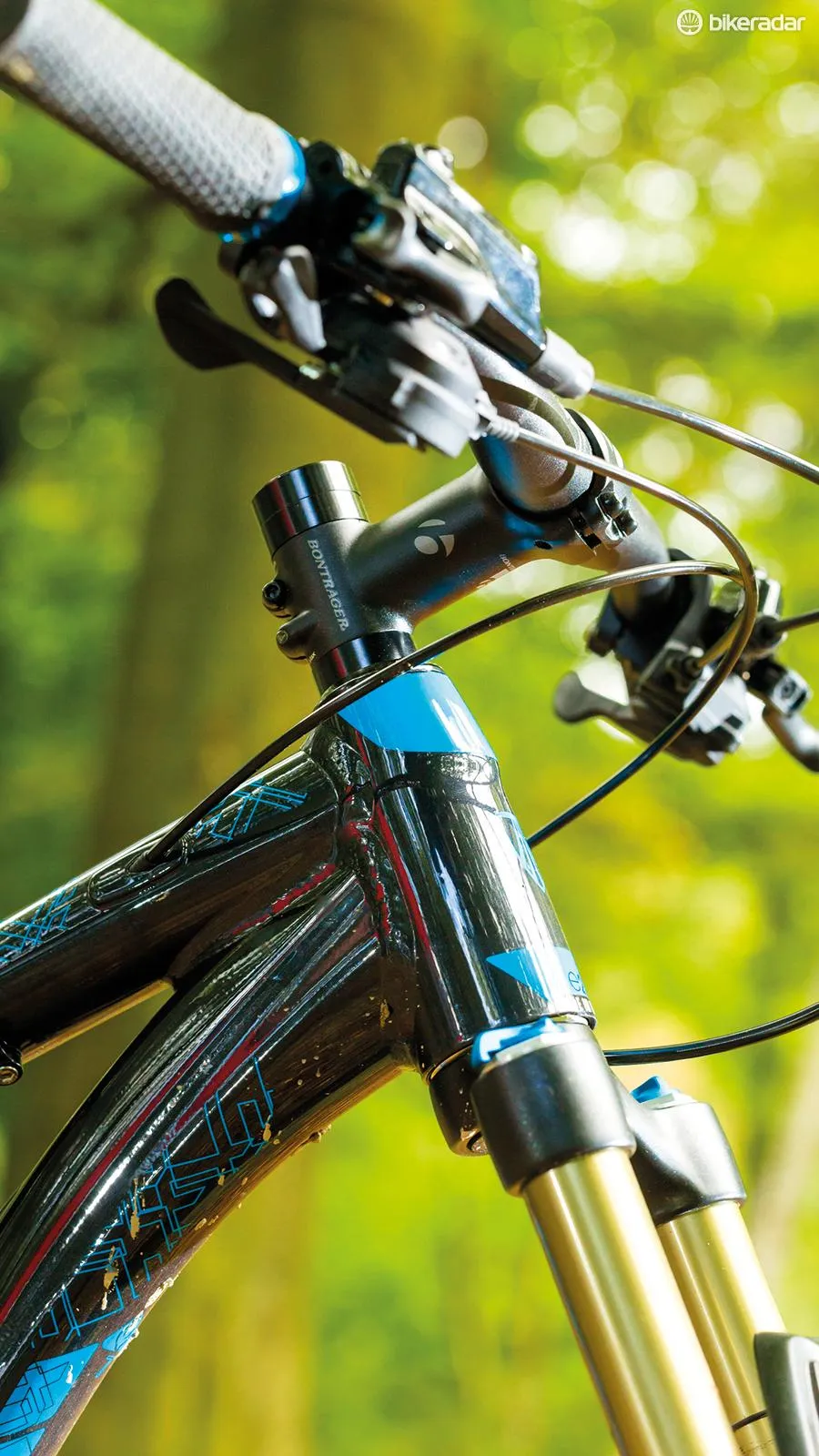
Cockpit choices aren’t radical but they are effective
Within a couple of corners it was clear that what was needed wasn’t more evolution but a real revolution. Its little 26in wheels clattered and skipped across the rocks of Snowdonia, spilling speed and confidence all over the place as they went. The alloy frame felt heavy, there was no swagger in its steering and it was obviously lacking the tailwind effect of bigger wheels. Even though we doggedly hung onto it as a long termer to try and tweak it better we never found the love.
Riding the top EX 9 alloy bike this summer it was clear the Fuel’s switch to 650b wheels (a 29er version is also available) has made a massive difference, and the lower spec, non Re:Aktiv EX 7 model proves the admission price for all-round get on and go fun is impressively affordable.
As with any good bike fit is crucial – and while Trek’s virtual sizing is a bit of a brain bend, the long top tubes and shorter seat tubes it generally delivers work well. Cockpit dimensions and geometry mean steering is stable enough when you need back up in a boulder fight or scree slide, but not so needy it demands constant correction when you’re climbing or cruising along skinny sheeptrack.

The Fuel's chunky weight means it takes a while to get up to speed, but once you're there it holds momentum with the best of them
Tracking of the Fox 32 fork is a bit vague at times, but the sensible rather than radical steering angles mean you’re never tricked into thinking there’s more traction or control than there really is. It’s the same story of holistic balance with the bars and stem. You could fit wider bars and a shorter stem but then you’d probably need the grippier XR4 tyre up front rather than the faster XR3 here, and you’d definitely notice the fork twist more. If that’s the sort of ride you want you’d probably be better off with the beefier, slacker, 140mm travel Remedy 7.
Our only significant criticism of the 7 is its weight, which makes acceleration steady rather than sudden compared with some of its peers. It generally hides its mass very well in the overall ride, to the point where it’s a surprise when you have to heave its heft over a gate. Once you’ve got it up to speed it holds onto it with a dogged amount of pride whether you’re half-wheeling mates up a fire road or battling up one of those climbs that would be better as a descent. The XR3 tyres underline overall performance with decent drag-free grip and they’ll feel and roll even better if you pop in the supplied tubeless strips and valves and switch tubes for sealant.
Frame and equipment: versatile setup that's ready for anything
Fox’s Evolution series dampers are far more consistent than they were last year so there are no nasty surprises in the fork stroke and setup couldn’t be simpler. Type your ready to ride weight into the online calculator on Trek’s website and it’ll give you starting point pressure and rebound settings to get you in the ballpark before you even get on the bike.

A Fox rear shock gets DRCV technology for a deep and plush feel
Once you’ve checked the sag with the provided clip-on marker, the rear suspension is equally unobtrusive. While it’s not as crisp and on point as the Formula One technology-inspired Re:Aktiv dampers on Fuel EXes, the split chamber DRCV shock is still strong under power and the automatic opening second shock chamber means it’ll take a fair wallop or drop without bucking you offline. The Descend, Trail and Climb modes are different enough to be worthwhile and it’s pedal, brake and chainring neutral enough that you can concentrate totally on the trail and not worry about how to make the bike work with each bit.
The same ready-for-anything attitude adds useful versatility to the rest of the frame. There’s a replaceable plastic belly guard because alloy bikes are just as likely to take a rock in the guts as a carbon frame. The bottom bracket has chainguide mounts in case you ever want to fit a chain device. There’s no direct compression shock load on the mainframe so the Alpha Platinum tubes can be made thinner and lighter. The magnesium EVO rocker link is forged in a single piece for maximum strength and stiffness compared to a welded or bolted multi-piece link. Internal routing is neat and it’s plumbed for an internally routed seatpost hose, which is great because a dropper post is the only thing that’s obviously missing when things get techy.
Ultimately this isn't the most radical ride and it’s heavy, but if you want a really well balanced, consistently friendly, get on and go trail bike then Trek’s entry-level EX 7 should be on your shortlist.
Share this article

- Terms & Conditions
- Subscribe to our magazines
- Manage preferences
Trek Fuel EX 2023 Review | A bigger, musclier & hugely adaptable trail bike
The not-so-minor details.
2023 Trek Fuel EX
https://www.trekbikes.com
$4,999 AUD - $8,999 AUD
- Sturdy, flex-free chassis - Superb geometry with adjustable head angle - Efficient & comfortable climbing performance - Coil shock, big fork & mullet compatibility - Mechanic-friendly frame furnishings - Internal storage
- Frame is on the heavy side - Rear shock tune lacks small-bump suppleness - Rattly rear thru-axle lever
Wil reviews the Trek Fuel EX 2023
Having undergone a ground-up redesign for 2023, the Trek Fuel EX has entered its burliest and biggest travel form yet. This latest model represents the 6th generation of Trek’s popular mid-travel trail bike, with the original having debuted all the way back in 2005. Trail riding has evolved a lot since then, and the new Fuel EX aims to keep up with that evolution by incorporating almost every mod-con you can think of.
Of course it’s big news whenever Trek releases a new Fuel EX, and given how important this bike is for the US brand, we were curious to see how the raft of updates would play out on the trail. We had a bit of an idea, having thoroughly enjoyed riding the electrified Trek Fuel EXe over the past few months. Would the muscle-powered version deliver the same good vibes? And how would it compare to the previous models that have given us so many fond riding memories over the years? We’ve been putting the Trek Fuel EX 2023 to the test to find out!
Watch our video review of the Trek Fuel EX 2023:
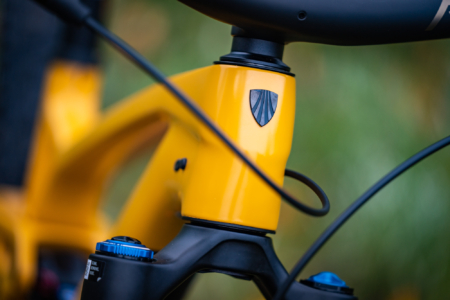
Along with the downtube storage, generous frame armour and size-specific chainstays, the Fuel EX appears to pack in almost everything you could possibly want in a modern trail bike.
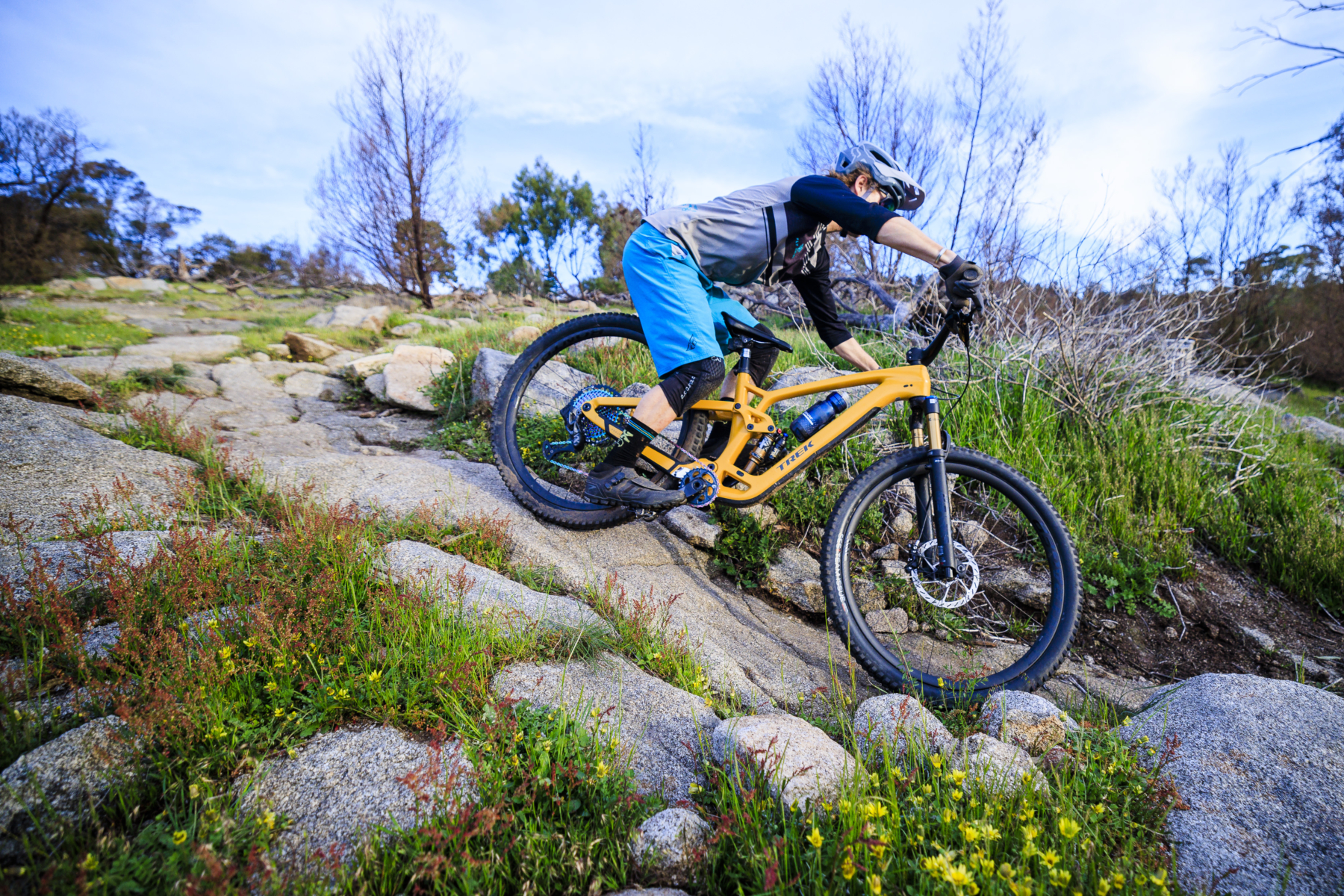
An overview of the Trek Fuel EX 2023
For 2023, the Trek Fuel EX is built around an entirely new frame that’s produced in carbon and alloy variants. Suspension travel has increased by 10mm at both ends, with the new Fuel EX now sporting a 150mm fork and 140mm of rear travel via the ABP four-bar suspension design.
It’s worth noting that the frame will handle a 160mm travel fork, and thanks to the two-position Mino Link, it can also be run as a mullet. Borrowed from the Session downhill bike, there’s a two-position flip chip at the lower shock mount that offers linear and progressive settings. The latter option is what makes the new Fuel EX coil shock compatible.
On top of that, Trek will be offering aftermarket headset cups to steepen or slacken the head angle by a degree. Along with the downtube storage, generous frame armour and size-specific chainstays, the Fuel EX appears to pack in almost everything you could possibly want in a modern trail bike. It’s certainly an appealing package on paper, and one that’s ready to take on contemporaries like the Specialized Stumpjumper , Merida One-Forty , Canyon Spectral and Giant Trance X .
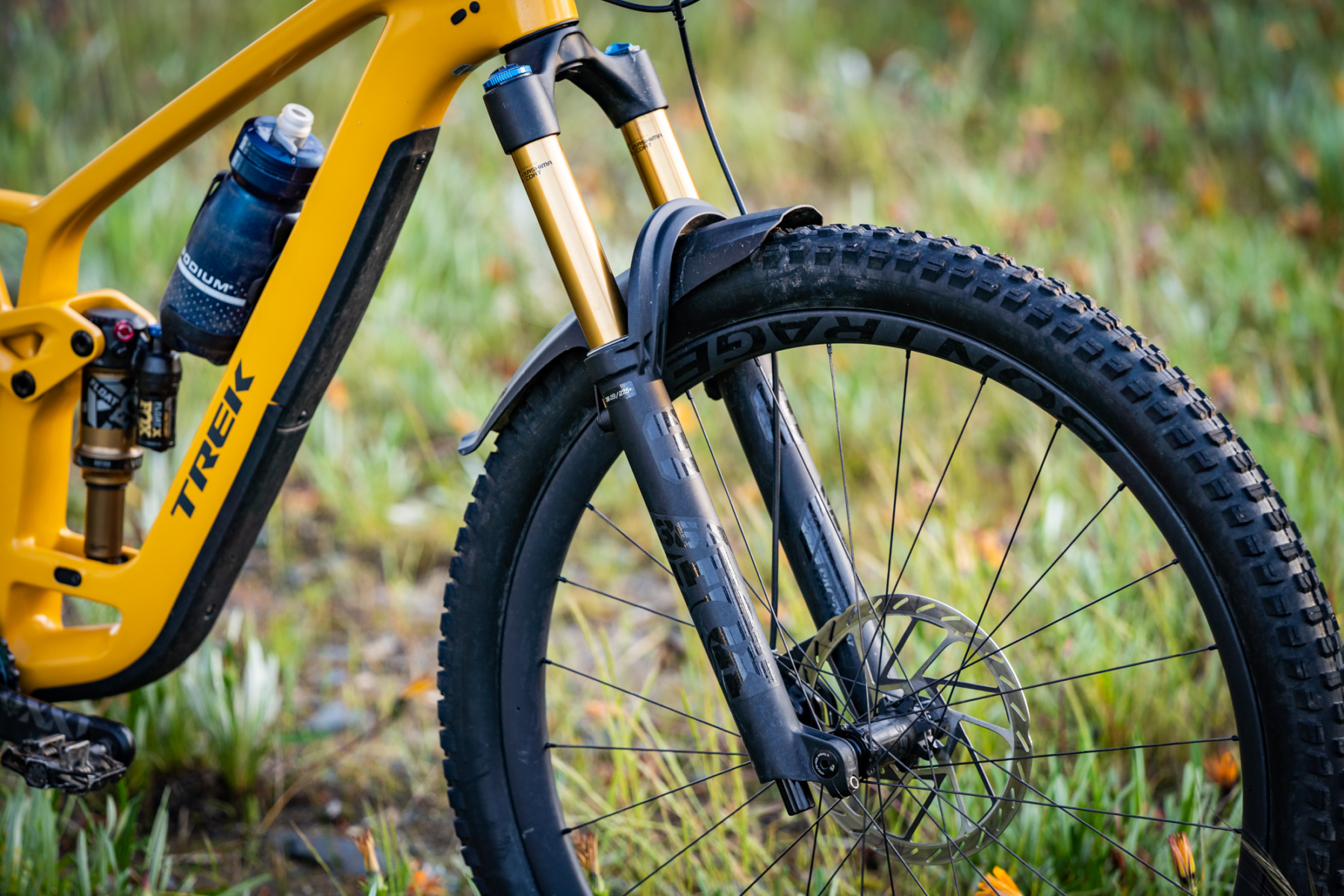
Trek Fuel EX price & specs
There are a number of different models available in the Trek Fuel EX 2023 lineup, though availability will vary depending on where you are in the world.
In Australia, prices currently range from $4,999 AUD for the Fuel EX 7, and go up to $8,999 AUD for the Fuel EX 9.8 XT model. The cheapest option is actually the Fuel EX 5, though that model carries over the previous generation frame. For a closer look at the specs, prices and all the new details, check out our Trek Fuel EX 2023 overview article for more.
Here we’ll be diving into our experience of testing the Trek Fuel EX 9.9 XX1 AXS model, which will be available in Australia in limited quantities through the custom Project One bike builder. It’s a media bike that was provided to us by Trek, and of course it comes dripping with lots of gold, carbon and wireless bits. However, as usual with our reviews, we won’t be going into detail about the Gucci-level spec. Instead, we’ll be concentrating on the important aspects that are shared throughout the Fuel EX lineup; the frame design, suspension performance and its on-trail handling.

2023 Trek Fuel EX 9.9 XX1 AXS
- Frame | OCLV Mountain Carbon Fibre, ABP Suspension Design, 140mm Travel
- Fork | Fox 36, Factory Series, GRIP2 Damper, 44mm Offset, 150mm Travel
- Shock | Fox Float X, Factory Series, 185x55mm
- Wheels | Bontrager Line Pro 30, OCLV Carbon Rims, 29mm Inner Width
- Tyres | Bontrager SE5 Team Issue 2.5in Front & Rear
- Drivetrain | SRAM XX1 Eagle AXS1×12 w/30T Crankset & 10-52T Cassette
- Brakes | SRAM Code RSC 4-Piston
- Bar | Bontrager RSL Integrated, OCLV Carbon, 27.5mm Rise, 820mm Width
- Stem | Bontrager RSL Integrated, OCLV Carbon, 45mm Length
- Seatpost | RockShox Reverb AXS, 34.9mm Diameter, Travel: 100mm (S), 150mm (M-M/L), 170mm (L), 200mm (XL)
- Saddle | Bontrager Arvada, Austentite Rails
- Confirmed Weight | 14.4kg
- RRP | $TBC
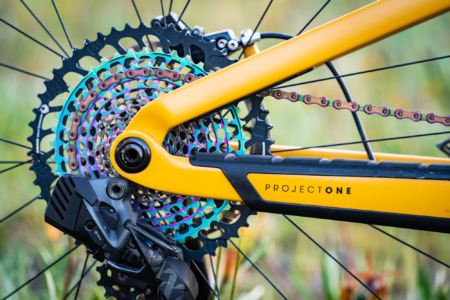
The chassis feels near-bombproof, and combined with the supportive suspension, powerful brakes and high volume rubber, you’re served up plenty of confidence for pushing the front wheel into steep chutes and over technical A-lines.

Trek Fuel EX size & geometry
From X-Small through to XX-Large, the Trek Fuel EX is produced in no fewer than seven different sizes. Seven! Given that many brands only offer four or sometimes even just three frame sizes, that’s impressive.
The two smallest sizes feature 27.5in wheels, while the Medium and above come standard with 29in wheels. The Small is the only option that is available in either wheelsize.
At 175cm tall I’ve been riding a Medium, which features a 450mm reach. Thanks to the use of short seat tubes, a rider of my height could easily upsize to the M/L size to get a longer 470mm reach. Personally, I’ve found the fit of the Medium to be spot-on.
As for geometry, the Fuel EX features a 64.5° head angle and approximately a 77.5° effective seat tube angle in its stock configuration. The rear centre length varies between sizes, going up to 450mm on the largest frame. On the Medium I’ve been riding, the rear centre is a compact 435mm.
Coming off the Fuel EXe, I found it easy to settle into the Fuel EX. The only modification I needed to perform was to chop the comically wide handlebars from 820mm down to a more reasonable 780mm.
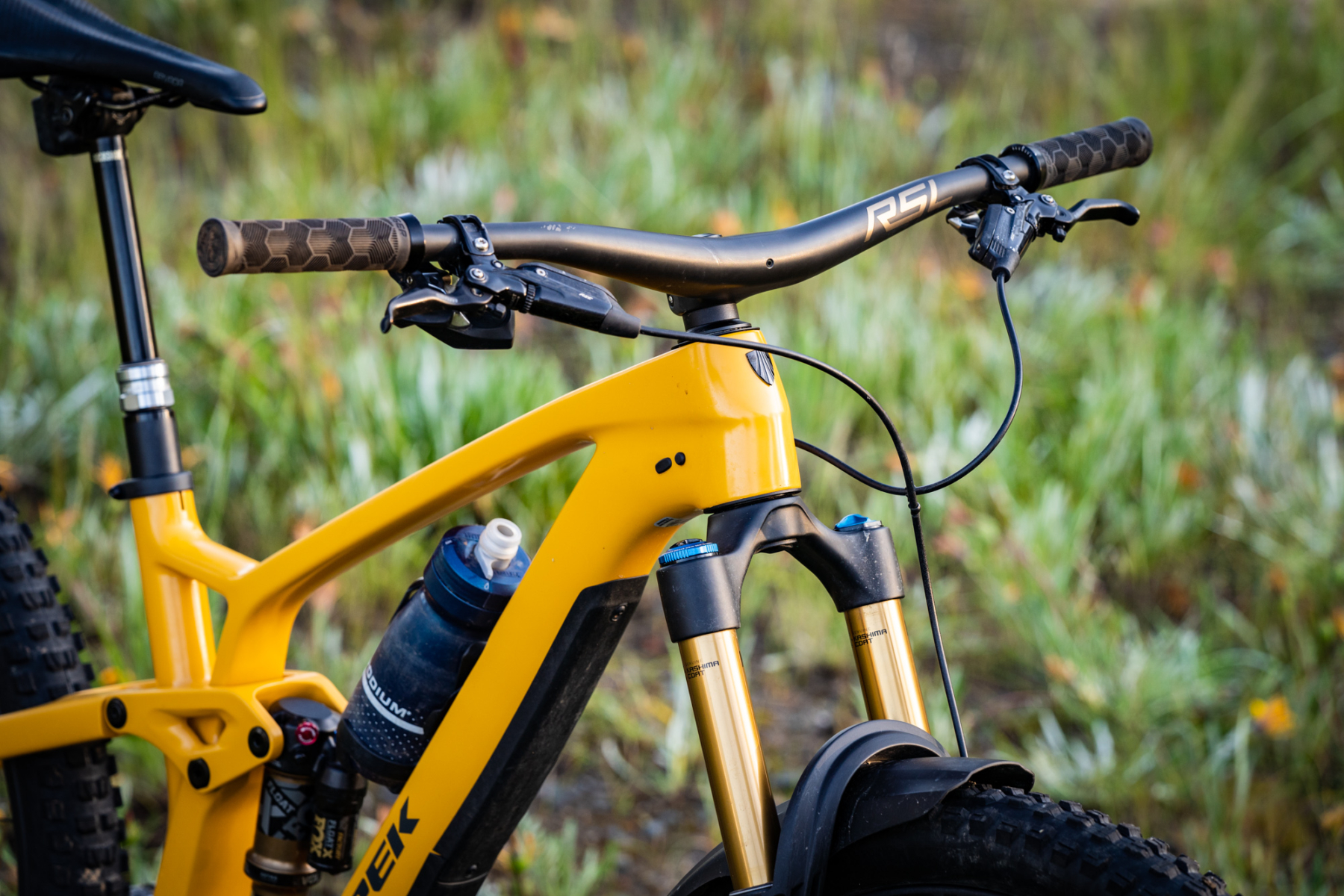
Suspension & tyre setup
Getting the Fuel EX set up is made easy thanks to Trek’s detailed online suspension calculator . Input the bike model and your riding weight, and out spits suggested air pressure and rebound settings for both the fork and shock. It even suggests tyre pressures, giving you a good place to start before hitting the trail. When brands like Canyon struggle to provide any recommendations at all, Trek should be commended for helping riders to get the most out of their bike.
For my 68kg riding weight, Trek suggests setting up the Fox 36 fork slightly softer and slower than usual. Recommended rear shock sag is 29%, and the calculator’s suggestion of 158psi got me to exactly that figure. Initially I set the rebound at 6/15 clicks as recommended, but while everything felt quite balanced front to back, the suspension was a little sluggish and duller than I wanted. Speeding up the rebound by a couple of clicks in both the fork and shock helped to make the whole bike feel a bit more lively, while improving small-bump reactivity.
Although the Bontrager SE5 tyres feature reinforced Core Strength casings, I still fitted a CushCore Pro insert to provide some additional pinch-flat protection and insurance for the carbon rims. Tyre pressures were set as per Trek’s recommendations with 20psi in the front and 22psi in the rear.
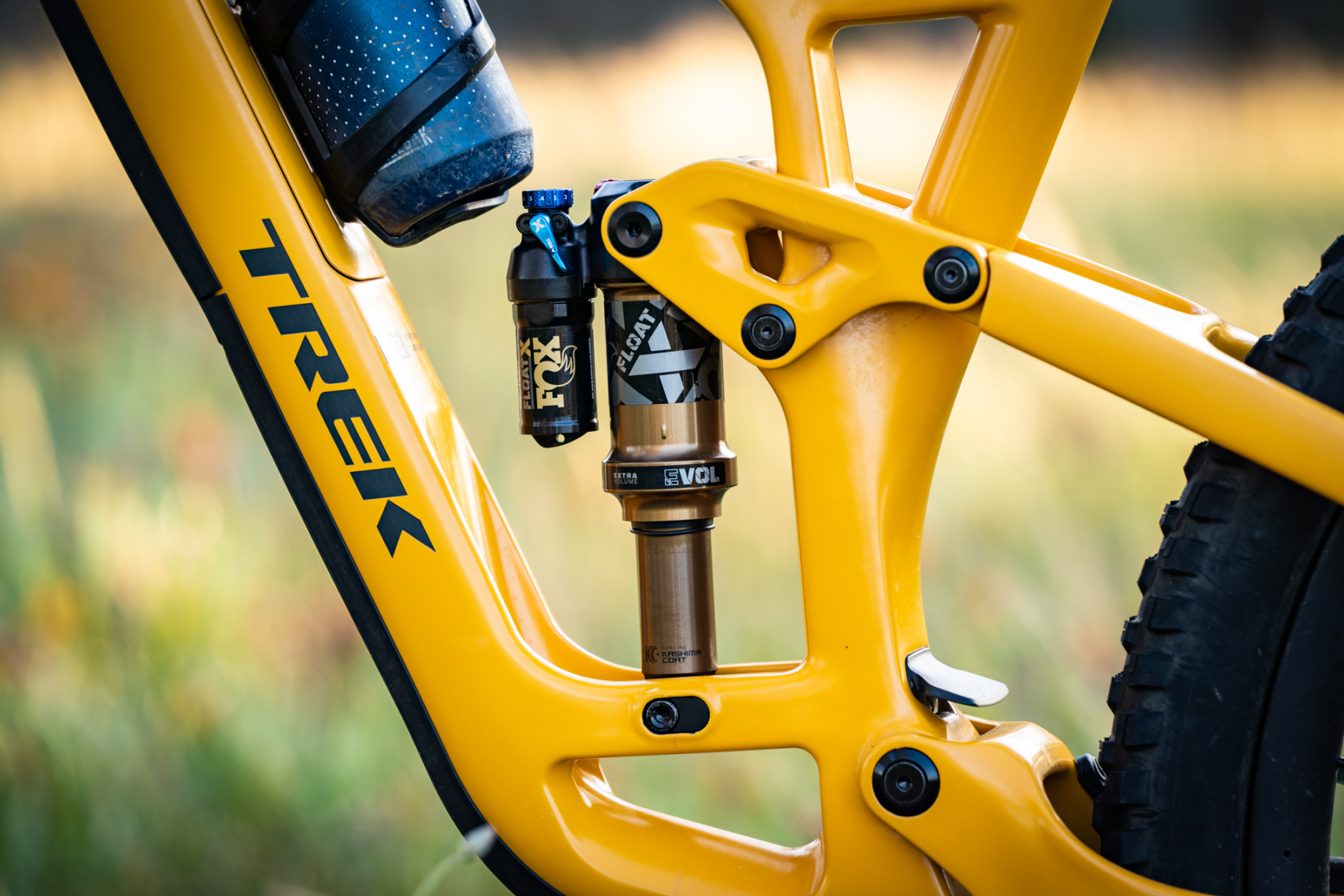
Trek Fuel EX weight
Confirmed weight for our Trek Fuel EX test bike is 14.4kg. That’s with the tyres set up tubeless, but without the CushCore insert or pedals.
It’s on the heavier side for a high-end carbon trail bike, though the 2.5in tyres, stocky carbon wheels and AXS components aren’t exactly the lightest going. Of course weights do vary throughout the Fuel EX lineup depending on the spec, and you can see the weights for all the different models in our range overview .
A contributing factor to the overall weight is the new frame, which has gained almost 700g over its predecessor. Trek claims the carbon frame weighs 3.4kg with the rear shock, making it a bit of a porker alongside some of the competition;
- Scott Genius HMX Carbon: 2,249g
- Specialized Stumpjumper Carbon: 2,280g
- Giant Trance X Advanced Pro 29: 2,498g
- Specialized Stumpjumper EVO Carbon: 2,750g
- Canyon Spectral CF: 3,047g
- Trek Fuel EX Carbon: 3,400g
The new alloy Fuel EX frame is heavier again, coming in at a hefty 4.6kg with shock.
Of course weight isn’t everything, and it’s unsurprising that the new frame has gotten heavier given how much longer and slacker it is. Still, for those who are especially concerned by grams, there are certainly lighter options on the market.
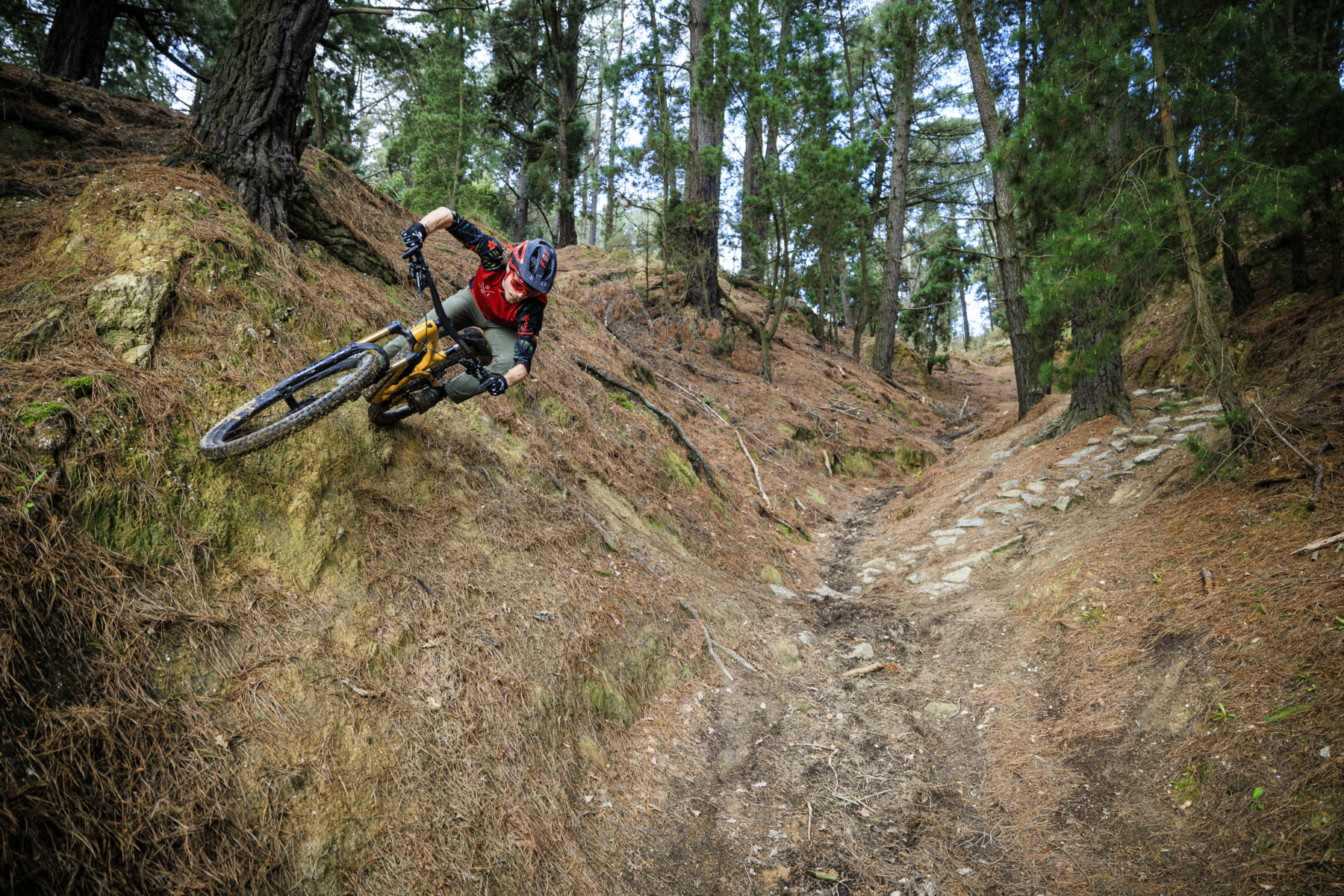
What do we dig about the Trek Fuel EX 2023?
With its added heft and updated geometry, the Trek Fuel EX 2023 is no doubt the burliest iteration yet. The chassis feels near-bombproof, and combined with the supportive suspension, powerful brakes and high volume rubber, you’re served up plenty of confidence for pushing the front wheel into steep chutes and over technical A-lines.
Indeed it’s massively capable for a 140mm travel bike, with the slack 64.5° head angle and roomy wheelbase giving it a purposeful stance on the trail. The geometry is superb, with welcome updates that have brought the Fuel EX right up to speed.
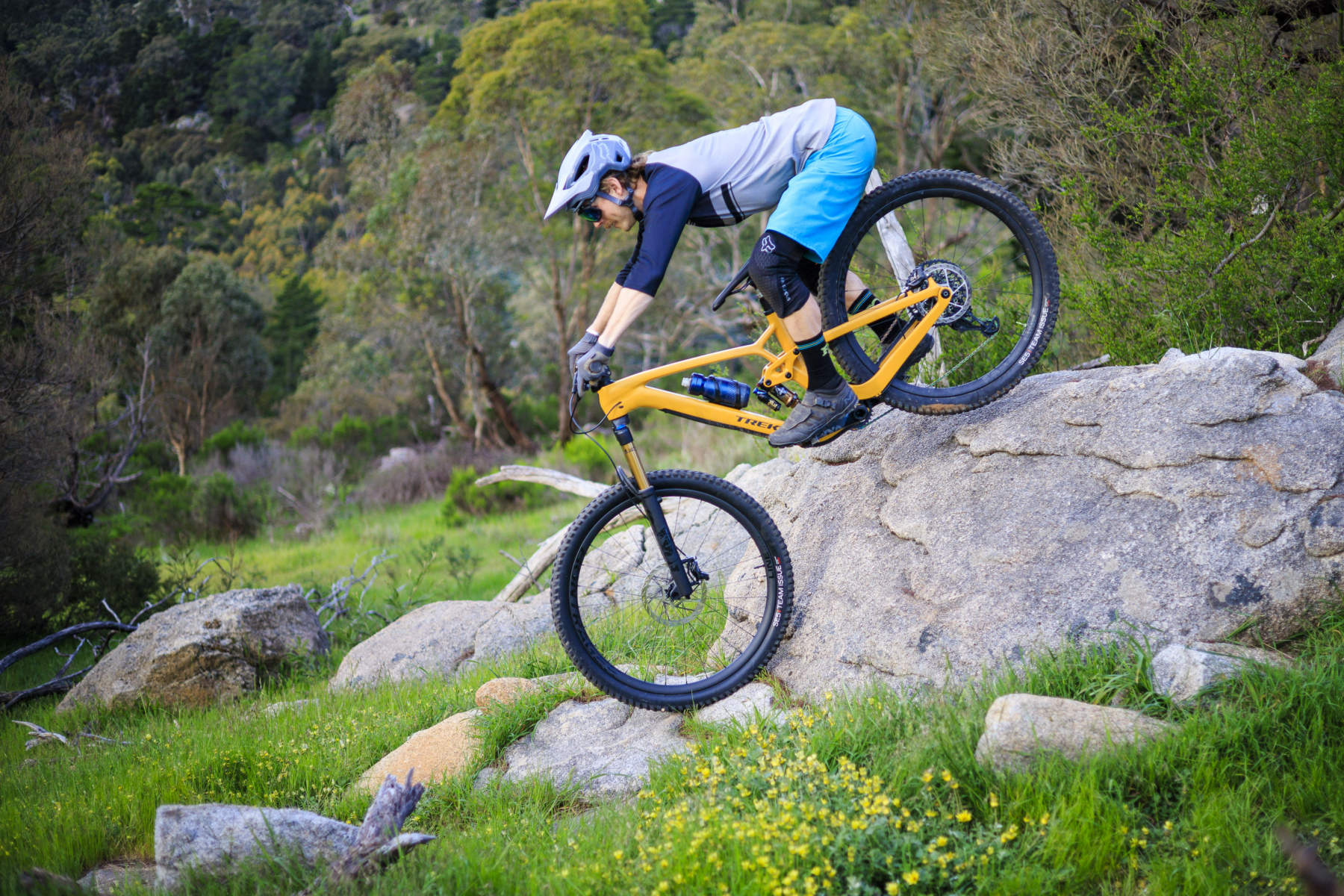
The steeper seat angle is particularly noticeable over the old bike, providing a much improved seated position on steep climbs. Pedalling efficiency has also levelled up. Trek has lifted the main pivot above the chainring to increase anti-squat, which helps to reduce pedal-induced bobbing. The Float X shock has a two-position climb switch, but I never once needed to use it while riding off-road since the rear end is so well behaved.

It rips through the turns
Once up to speed on flower singletrack, the taut chassis means the Trek Fuel EX is highly responsive when rounding corners and pushing into berms.
With its boxy downtube, split top tube and the supporting strut for the lower shock mount, the front triangle is heavily braced to resist torsional flex. Along with the wide main pivot and boxy one-piece chainstays, the Fuel EX possesses a strong spine from its shapely head tube to the rear thru-axle. The muscly frame effectively translates handling inputs while resisting lateral deflection through the turns.
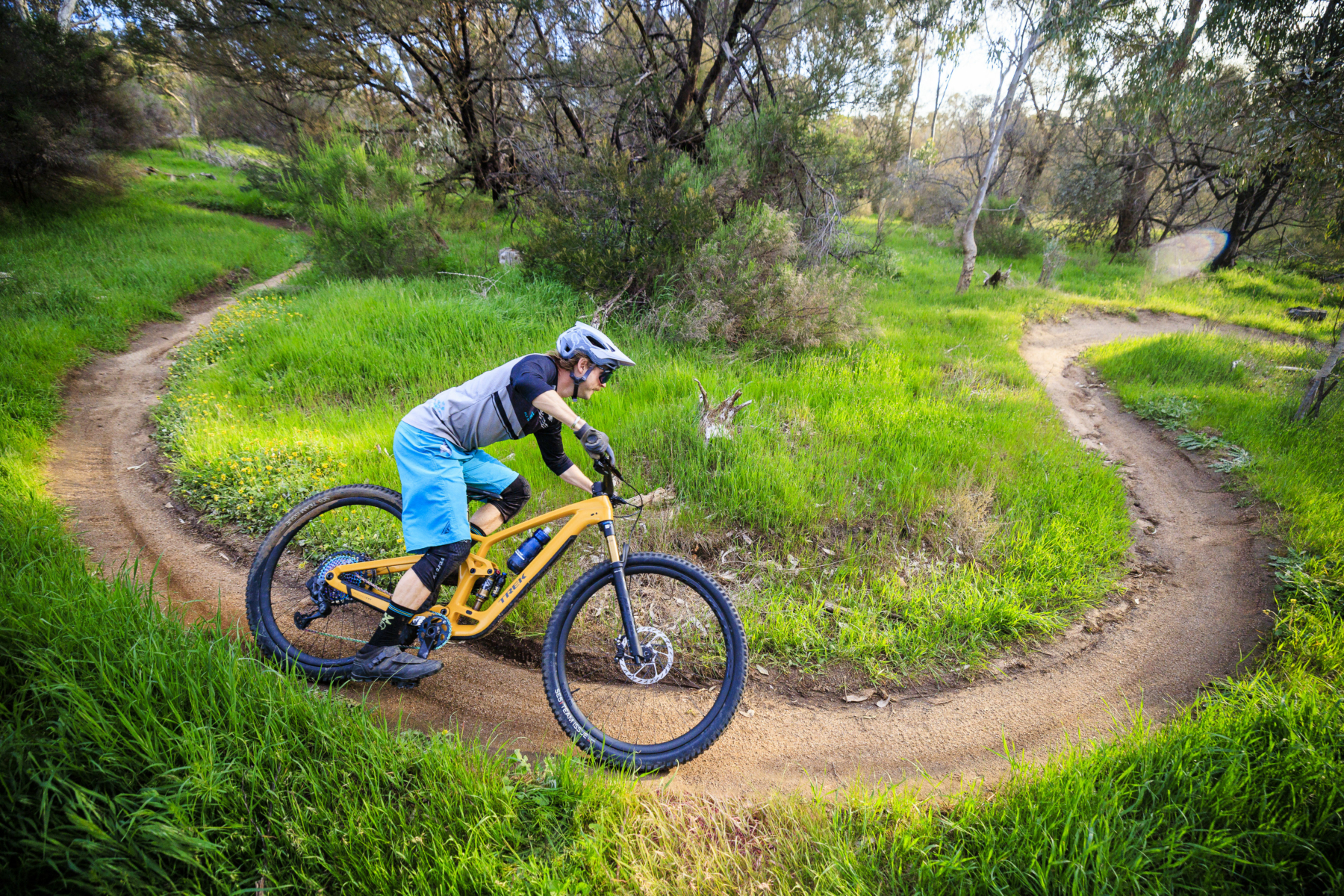
Likewise, the short rear end and generous 38mm BB drop are fantastic when threading your way through twisty sections of trail, keeping you connected to the terrain and contributing to the playful ride quality. The low-hanging BB did mean I caught the pedals occasionally, so those who frequent off-piste terrain and technical climbs will want to consider flipping the Mino Link into the High position to indulge in an extra 7mm of pedal clearance.
Otherwise the riding position and weight distribution are totally sorted. The handling is approachable, and the Fuel EX doesn’t demand a whole lot from you as the rider. Compared to the old bike it does need a more concerted lean when entering tighter corners, though this is a part of the natural evolution of modern trail bike geometry. Even if you’re coming off a 5-year old bike, you’ll only need a few rides to get accustomed to the Fuel EX’s steering behaviour.
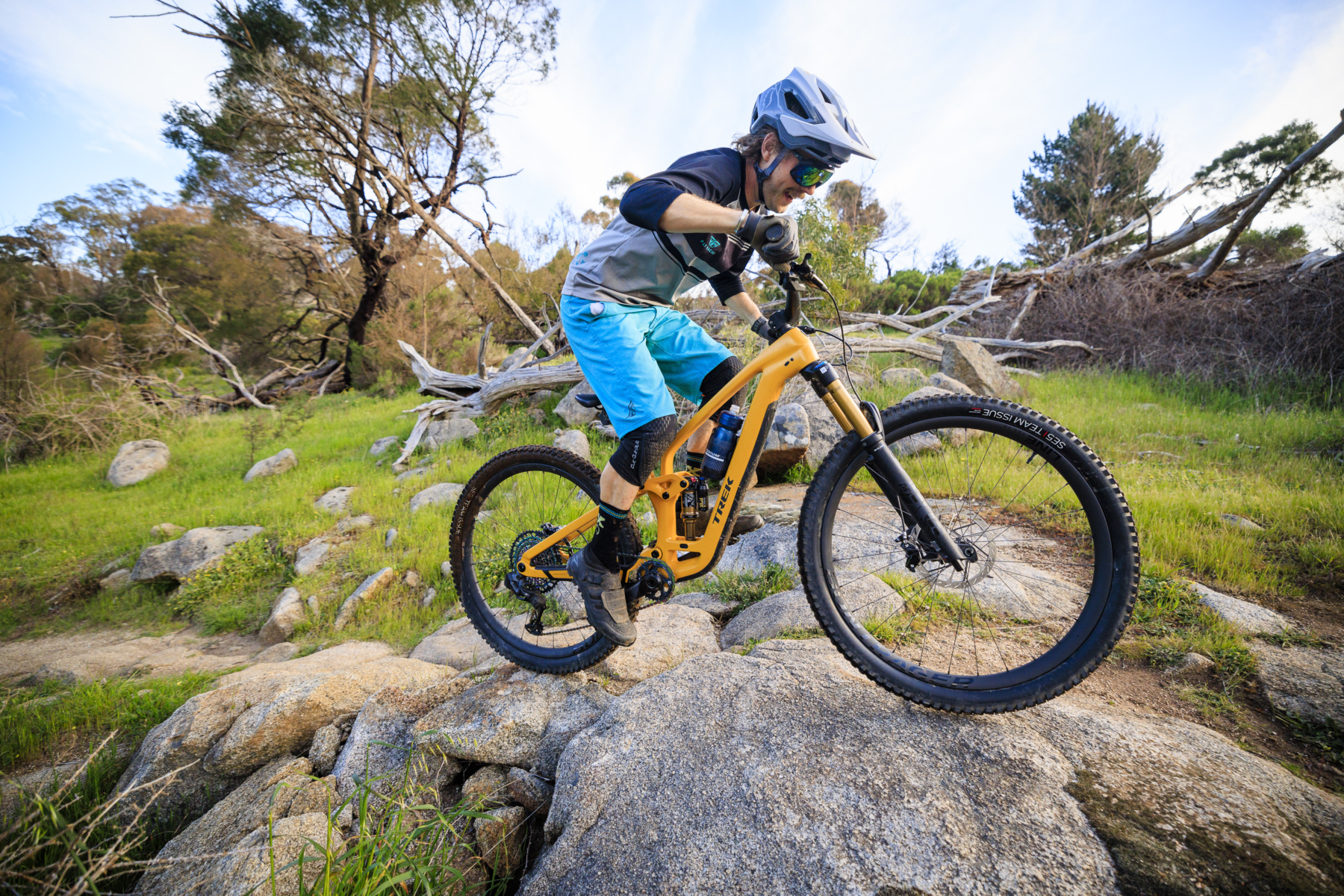
Trail-tweakable
In addition to the Mino Link, we’ve also been experimenting with the lower shock flip chip on the Trek Fuel EX. Requiring just a single 6mm hex key, it’s a quick adjustment to make trailside, and the change in suspension behaviour is noticeable.
I ended up preferring the ‘Less’ setting, which provides a more linear leverage rate. With the shock set at the recommended sag, this position provides great pedalling support, along with more comfort and activity deeper into the stroke. There’s still a good deal of progression though. Combined with the large bottom-out bumper in the Float X shock, hitting full travel proved to be a well-controlled affair.
One of our fellow testers, who generally spends more time in the air than on the ground, preferred riding in the ‘More’ setting. This increases progression, providing a stronger ramp-up in the latter half of the travel. He also reduced the shock pressure by 5psi to further enhance small-bump compliance, while still being able to enjoy the additional big-hit support. Pedal efficiency isn’t as stable in this setting, but it does mean the Fuel EX takes to jumps like a duck to water, popping off lips enthusiastically and absorbing hard landings with a solid and flex-free touchdown.
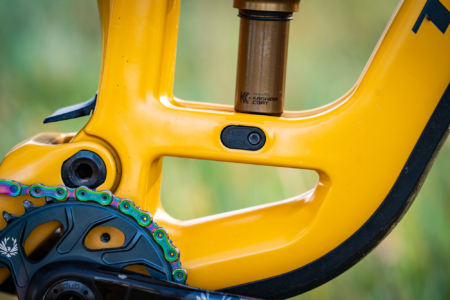
One thing to note on the More/Less flip chip is that while you are altering the progression of the air spring, you’re also affecting the damper too. As well as adjusting air pressure, we found we needed to tweak the rebound and low-speed compression settings between the two positions. It is indeed a useful tuning tool, but it doesn’t dispel the need for air volume spacers entirely.
What does it struggle with?
With the Trek Fuel EX adopting a beefier frame, the added weight is noticeable compared to lighter bikes in this category. That’s compounded by the heavy-duty brakes, stocky wheels and chunky tyres, which mean there’s more inertia to overcome during micro-accelerations on an undulating climb.
For those who are looking for a sharper and sprightlier trail bike to whip through the trees along smoother singletrack, the latest Trek Top Fuel will be a better fit. In comparison, the new Fuel EX is a burlier beast that thrives on steeper and more technical terrain.
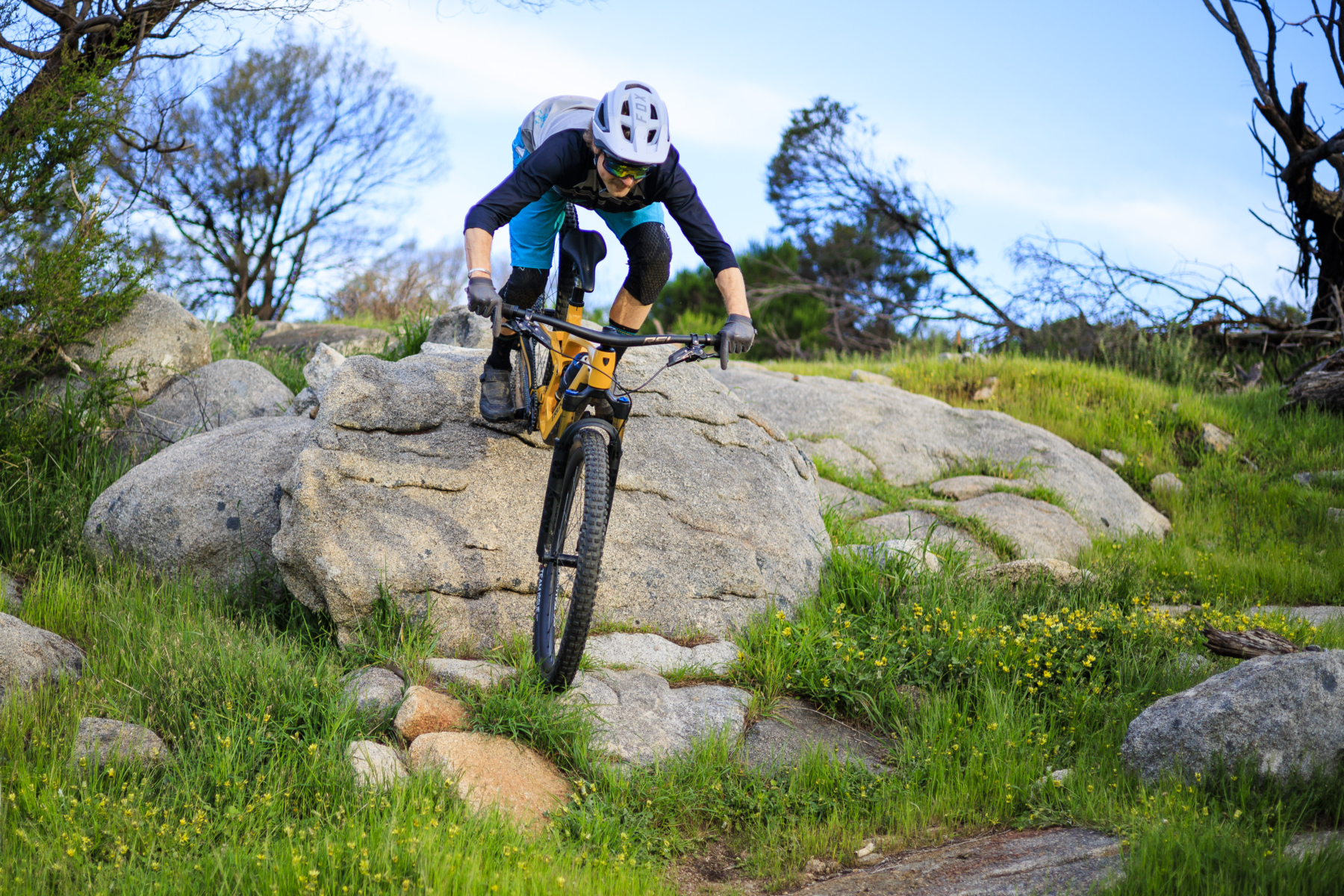
Curiously, it does feel stiffer than the electrified version, the Fuel EXe . Despite both our test bikes featuring carbon frames with a near-identical build kit, I’ve found the Fuel EX to transmit more trail feedback.
Some of this may be due to structural differences, and perhaps the more favourable sprung-to-unsprung mass ratio on the electric version thanks to the added weight of the motor and and battery. Either way, the Fuel EX doesn’t exactly exude off-camber compliance. As a lighter rider on very rocky terrain, I’ve found myself getting knocked around a little more than I would like.
This sensation reminded me of the Canyon Spectral 125 , which proved to be overly stiff and quite uncomfortable at slower riding speeds. The Fuel EX is more compliant overall than the Spectral 125, but it’s still pretty stiff.
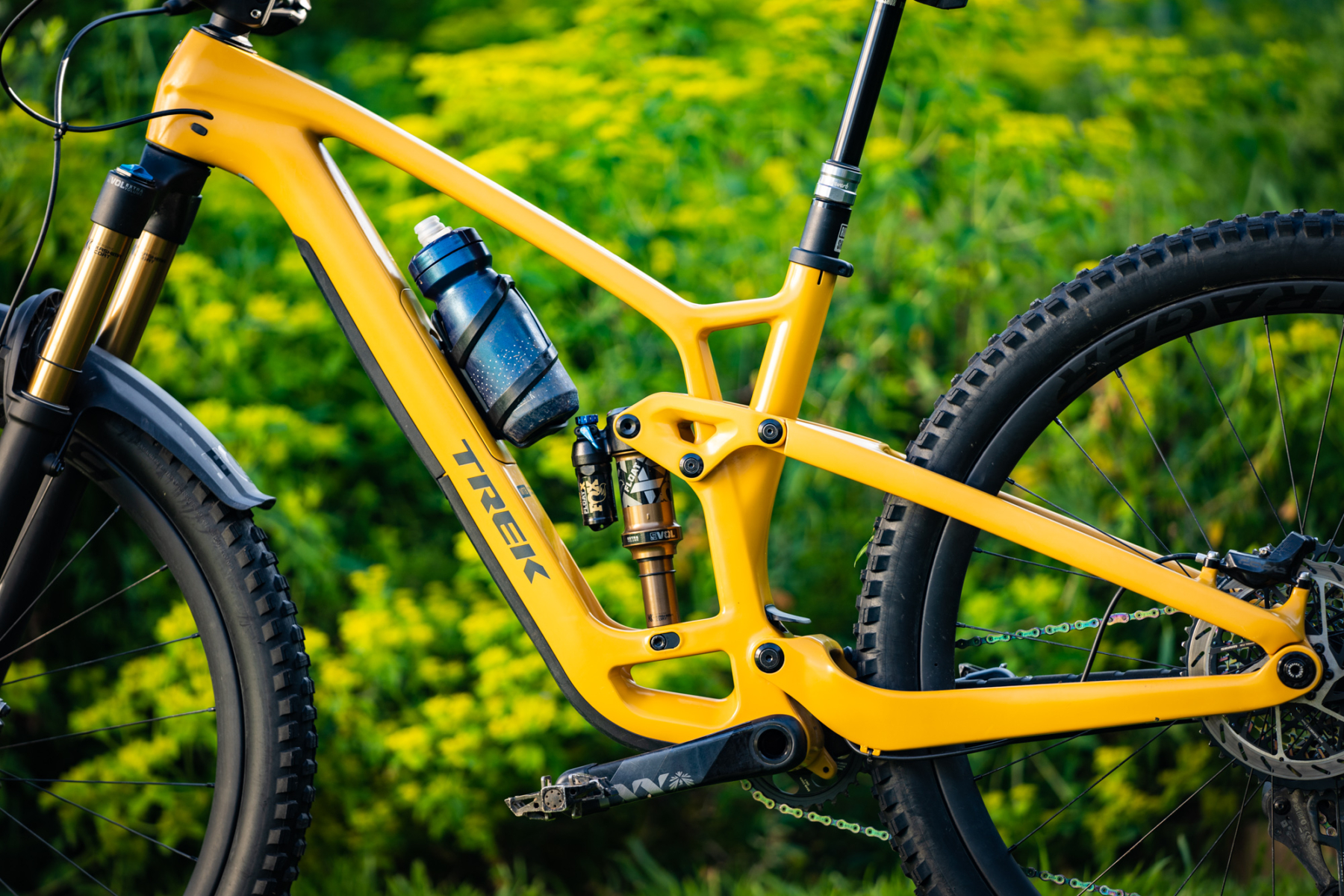
It’s not as supple as Fuel EX models gone by
Contributing to this sensation, the suspension isn’t as plush as previous Fuel EX models, particularly those that featured the Thru Shaft shock. Those bikes did require the rider to make use of the compression lever to provide pedalling support, but it meant that in the open mode the rear end absorbed the terrain like melted butter.
You may have noticed that Trek has been making a conscious move away from proprietary suspension components lately, and that’s coincided with building bikes that offer more neutral pedalling performance. The increased anti-squat is one part of the equation on the new Fuel EX, and the other part is the custom-tuned Float X, which Trek has configured with a digressive compression tune on the main piston. This creates a decent low-speed threshold, which provides a level of support that sits between the Open and Medium settings on the previous RE:aktiv damper.

The result is that you can ride with the shock fully open, and the Fuel EX still offers great stability under pedalling inputs, with no real need to activate the climb switch. If you detest remote lockouts and having to flip shock levers all the time, this will certainly be appealing.
The downside is that the suspension isn’t as supple over smaller rubble and at slower speeds. Along with the stiff chassis and carbon wheels, more of those vibrations are transmitted to the rider. As such, careful consideration with tyre pressure is needed to maximise grip and comfort.
Because there is more support however, the Fuel EX gives your feet a stronger platform to push off of, with greater feedback during high-load scenarios. Indeed the harder and faster you push, the better the Fuel EX responds. In that sense, it’s less of a comfy cruiser like its predecessors, and more of a mid-travel bruiser that loves to ride hard and fast.
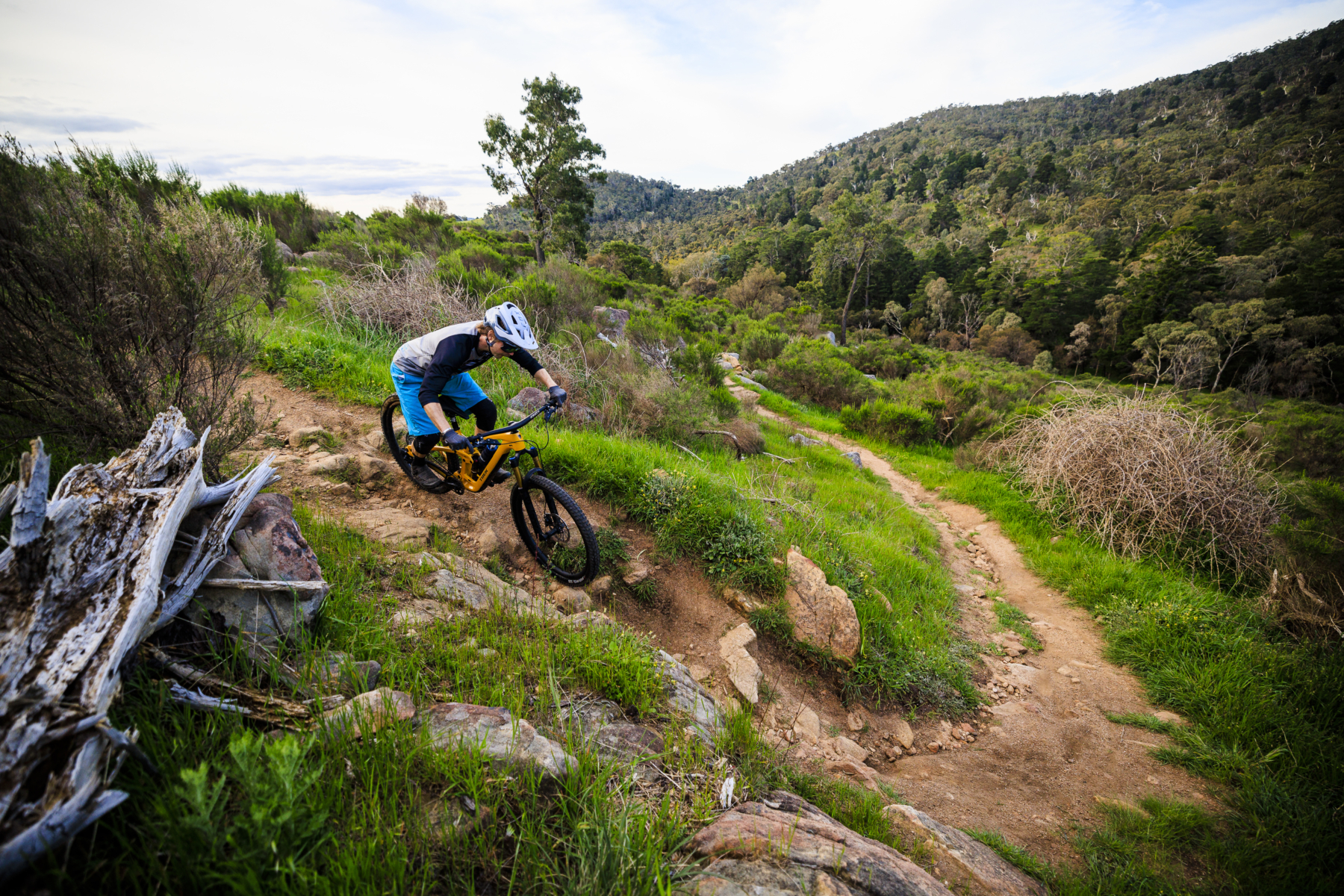
Component highs & lows
As a complete bike, the Trek Fuel EX is a solid package that puts the emphasis on capability over light weight.
The Bontrager SE5 tyres are a good example, coming in at 1,100g each on our workshop scales. They roll reasonably well given their weight and size, and we’ve found them to provide consistent grip on rocky, hard-packed soil, which will suit most Aussie trail riders. The tread is a little shallow though, and the compound isn’t the softest, which sees them struggling to latch on when the conditions are wet and loose. We’d prefer something a little stickier and toothier up front, like a Maxxis Minion DHR II with 3C MaxxGrip rubber.
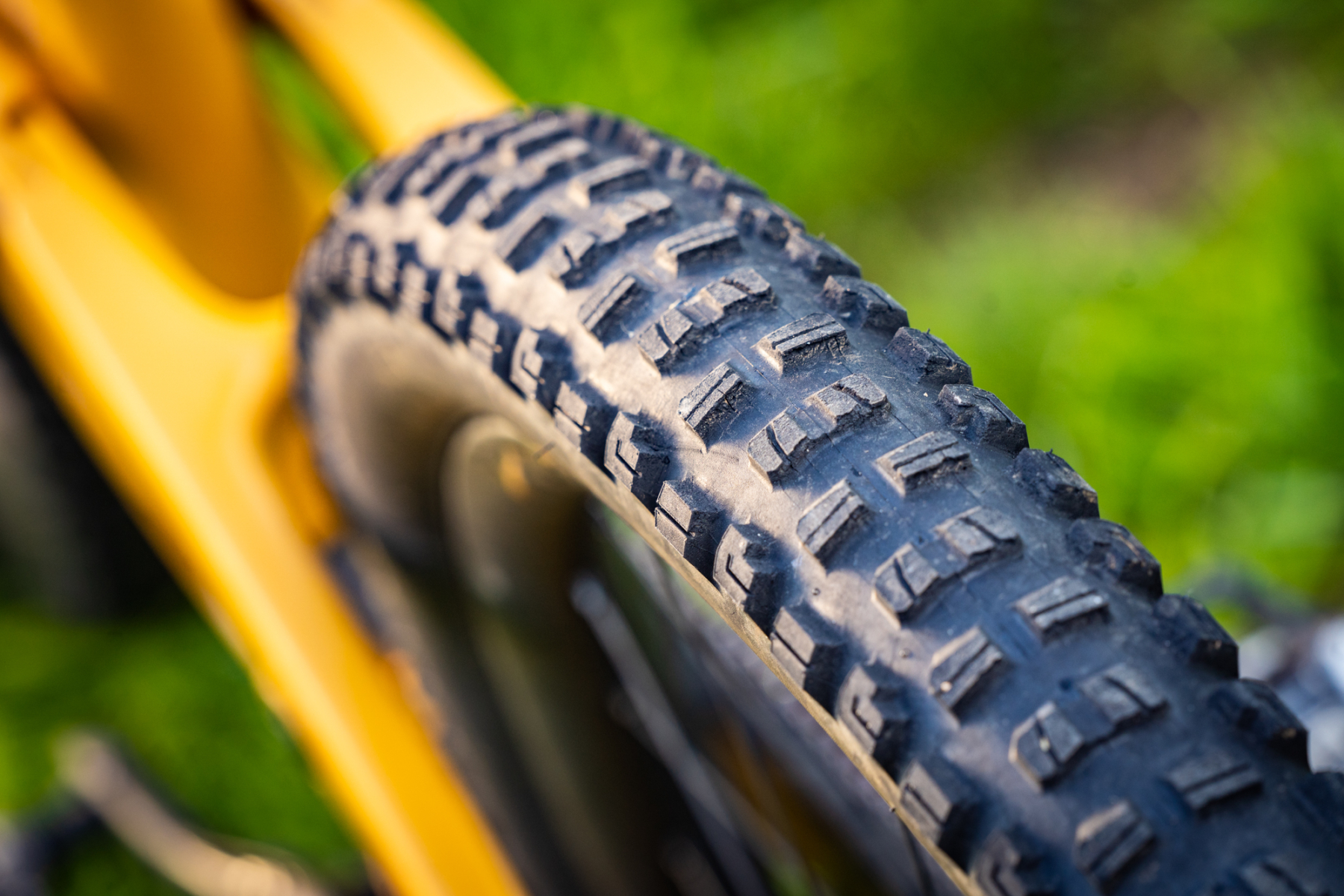
While the carbon Bontrager Line Pro rims are quite stiff, they have proven to be plenty tough. We’ve tested five of these wheelsets across various bikes over the past few years and we’ve not encountered a single issue. The y also come with a two-year crash replacement guarantee, which is great insurance given the hell that you can put this bike through. Furthermore, the frame itself comes with a lifetime warranty for the original owner.
There’s still plenty of real-world protection though, including a generous two-piece armour plate that bolts to the underside of the downtube. There’s also a metal chain-suck guard behind the chainring, and a full-coverage chainstay protector. Along with the fully guided internal cable routing, the Fuel EX is an impressively quiet and rattle-free bike on the trail. Well, except for the rear thru-axle lever, which I removed after the first ride.
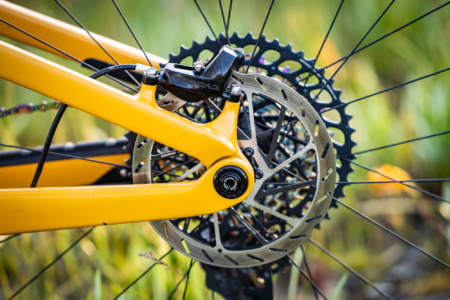
Otherwise the finishing details are all sound. The adoption of a bigger 34.9mm seat tube diameter is welcome, as it accommodates a stiffer and stronger dropper post, particularly for the larger sizes. Mechanics will be happy to see a threaded BB shell, and we’re fans of the downtube storage. The trap door has none of the play that we encountered on the last Fuel EX we tested, with a tight fit and a nice lever action.
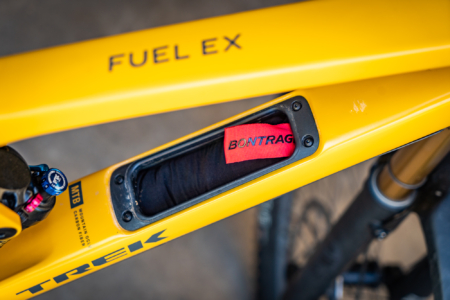
It’s certainly a high quality chassis, and many riders are likely to appreciate the in-built versatility. We’re looking forward to trying out the adjustable head angle once the aftermarket cups become available, and we’d also be keen to try out the Fuel EX with a coil shock. Setting it up as a mullet will be more straightforward, especially as you only need to buy an air spring to extend the Fox 36 up to 160mm of travel.
Trek Fuel EX vs Specialized Stumpjumper
Alongside the Trek Fuel EX, the Specialized Stumpjumper is one of the most popular and well-known trail bikes in this category. In terms of travel and the overall build, the Fuel EX sits right in between the regular Stumpjumper and the Stumpjumper EVO. However, it’s the regular Stumpy that I’ve been spending the most time on lately, both in its stock configuration and with a burlier mullet setup .

Compared to the Fuel EX, the Stumpjumper has a touch less travel with a 140mm fork and 130mm at the rear. It also uses a simpler suspension layout, with the carbon models employing a flex-stay design. Combined with its slimmer tube profiles, the carbon Stumpjumper frame is very light. Specialized claims it weighs just 2.28kg including the shock, which is over a kilo lighter than a carbon Fuel EX.
This theme extends to the Stumpjumper’s build kit, with Specialized electing for the skinnier Fox 34 over the 36. Along with an in-line shock, lighter brakes, wheels and tyres, there’s a considerable difference in the overall bike weight. For example, the Stumpjumper Pro we tested weighed 12.84kg.
While the geometry is pretty similar between the two bikes, the Specialized Stumpjumper rides much lighter on the trail compared to the Trek Fuel EX. It offers more comfort, with its lithe chassis and smooth suspension performance providing better compliance over rough terrain. It’s quite sporty and sprightly, though its active suspension design does need taming on the climbs by making use of the rear shock’s compression lever.
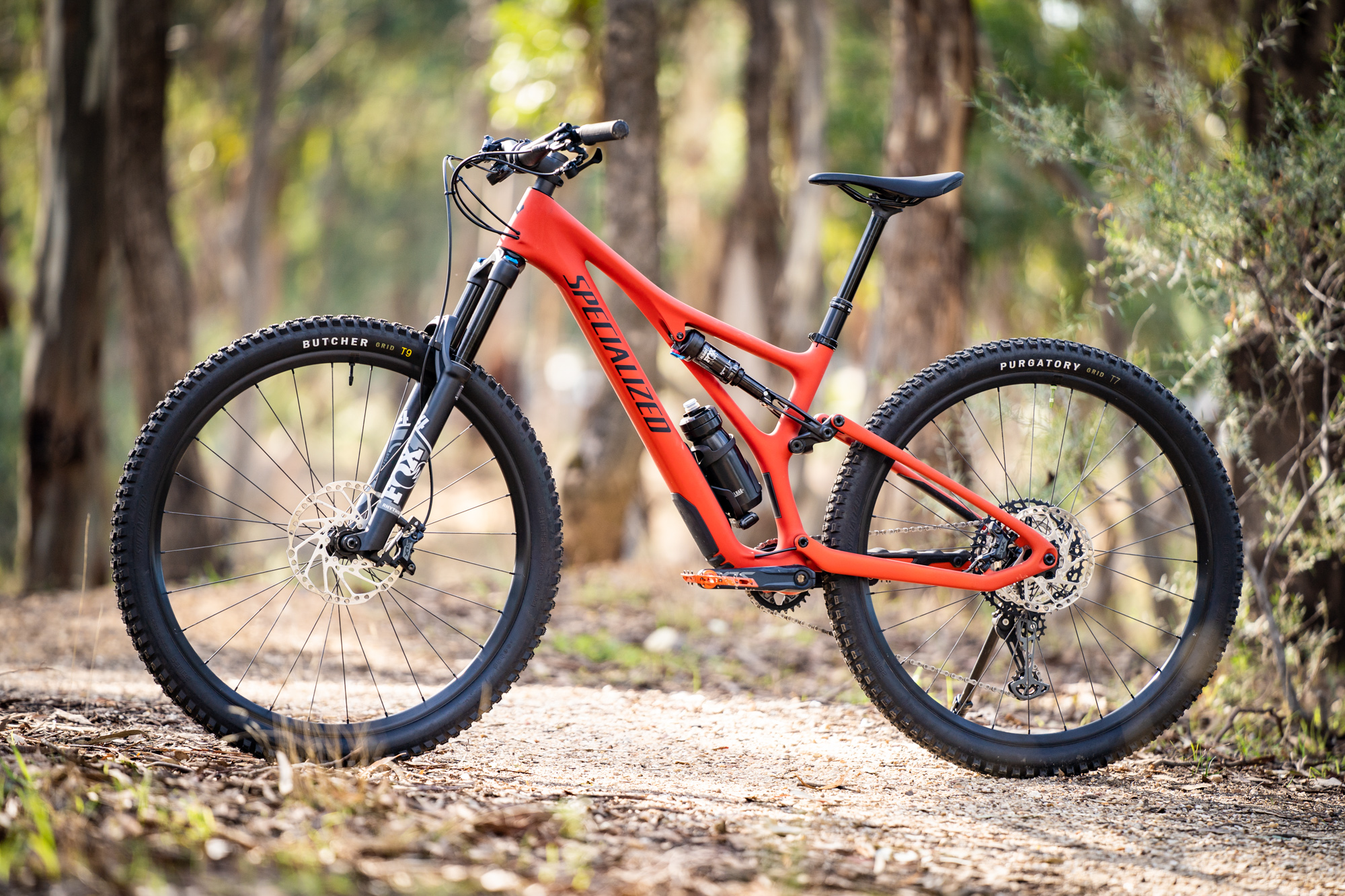
In comparison, the Fuel EX is more naturally efficient. It’s also more planted at speed, with its sturdy chassis and supportive suspension providing better big-hit capability. It feels more like a short travel enduro bike, which will suit heavier and harder riders.
Both bikes will handle a longer fork and can be set up as a mullet, though Specialized makes a specific link for the Stumpjumper to maintain the stock geometry. There is greater versatility in the Fuel EX chassis, with the option to adjust the head angle and fit a coil shock.
As for value, the Fuel EX offers a more appealing spec package. A Stumpjumper Expert sells for $9,800 AUD and comes with a Fox 34 GRIP2 fork, SRAM G2 brakes, an X01 drivetrain, alloy wheels and handlebars. In comparison, an equivalent Fuel EX 9.8 XT sells for $800 AUD less. It gets a simpler GRIP damper for its Fox 36 fork, though it does feature a piggyback shock, a Shimano XT groupset, a carbon one-piece RSL cockpit and carbon wheels with that 2-year crash replacement guarantee.
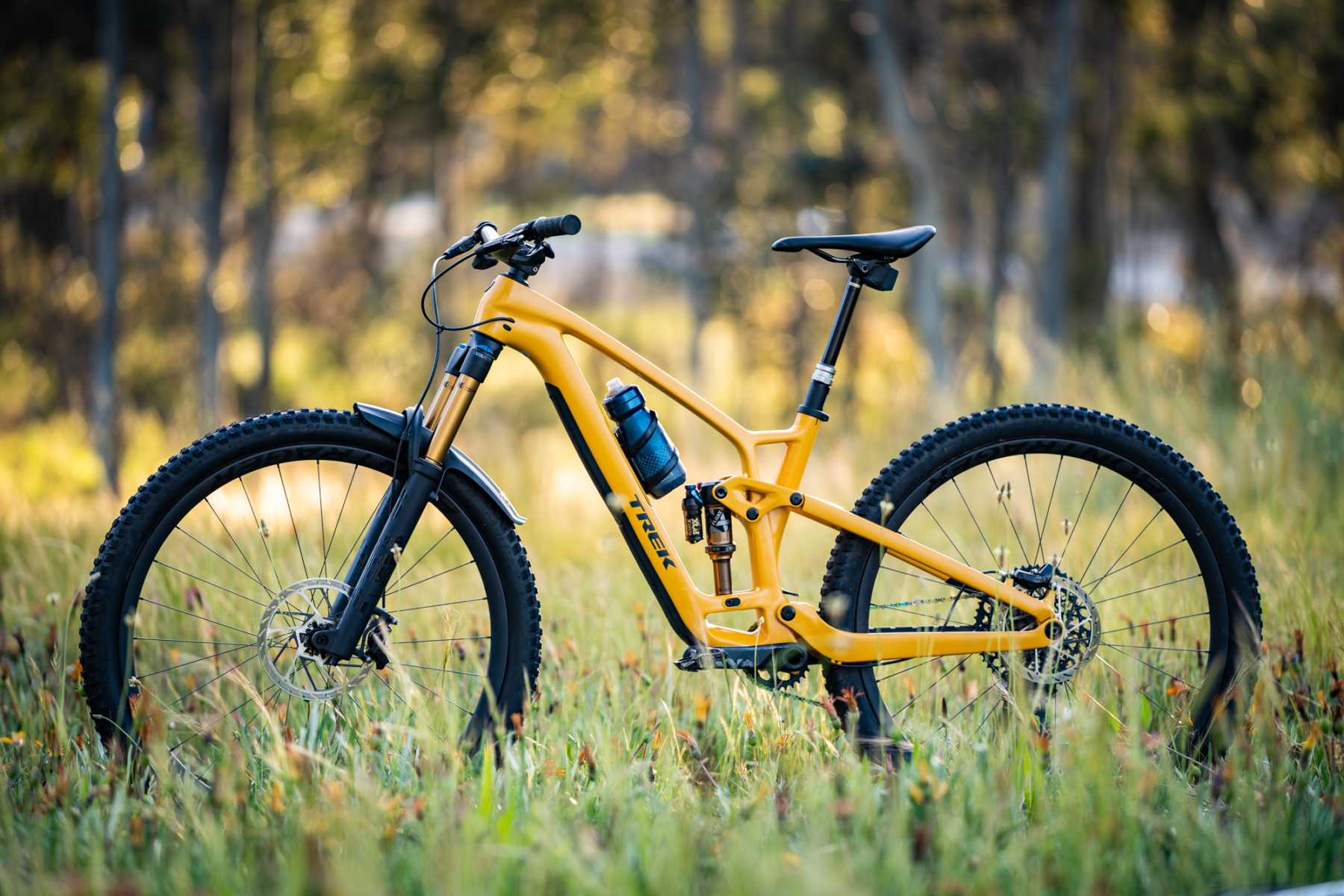
Flow’s Verdict
For many trail riders, the Trek Fuel EX 2023 is likely to tick just about every box on your new bike wish list. It’s as up to date as it gets, featuring loads of adjustability, internal storage and a nuanced approach to its size-specific geometry. Along with the increased travel and muscly frame, it offers greater stability and big-hit control over its predecessor, while still being a fun and involving bike to ride on modern flow trails.
It is a bit of a chonker though, so those who are looking for a lightweight and speedy trail bike may be better served by the latest Top Fuel .
The stiff chassis and supportive suspension also mean the Fuel EX tends to transmit more feedback, making it less comfortable to ride over rocky terrain. We’d be curious to try out a lighter shock tune to see how much of a difference that would make to the overall ride quality, but in its stock form the Fuel EX isn’t as plush as competitors like the Giant Trance X and Specialized Stumpjumper .
It is impressively efficient though, and the stable suspension gives you a load of support when you’re really giving it the beans on the descents. In this sense, the Fuel EX is closer in feel and performance to an enduro bike. You’ll still want to look towards the Slash if you’re serious about racing, but outside of the tape the Fuel EX will handle just about everything a modern trail centre or bikepark could throw at it. And for those who really want to up the limits, the adaptable chassis can easily be configured for some pretty aggressive riding.
Indeed for those who are chasing maximum capability without going to a big, spongy enduro bike, the Fuel EX is a mighty appealing option.
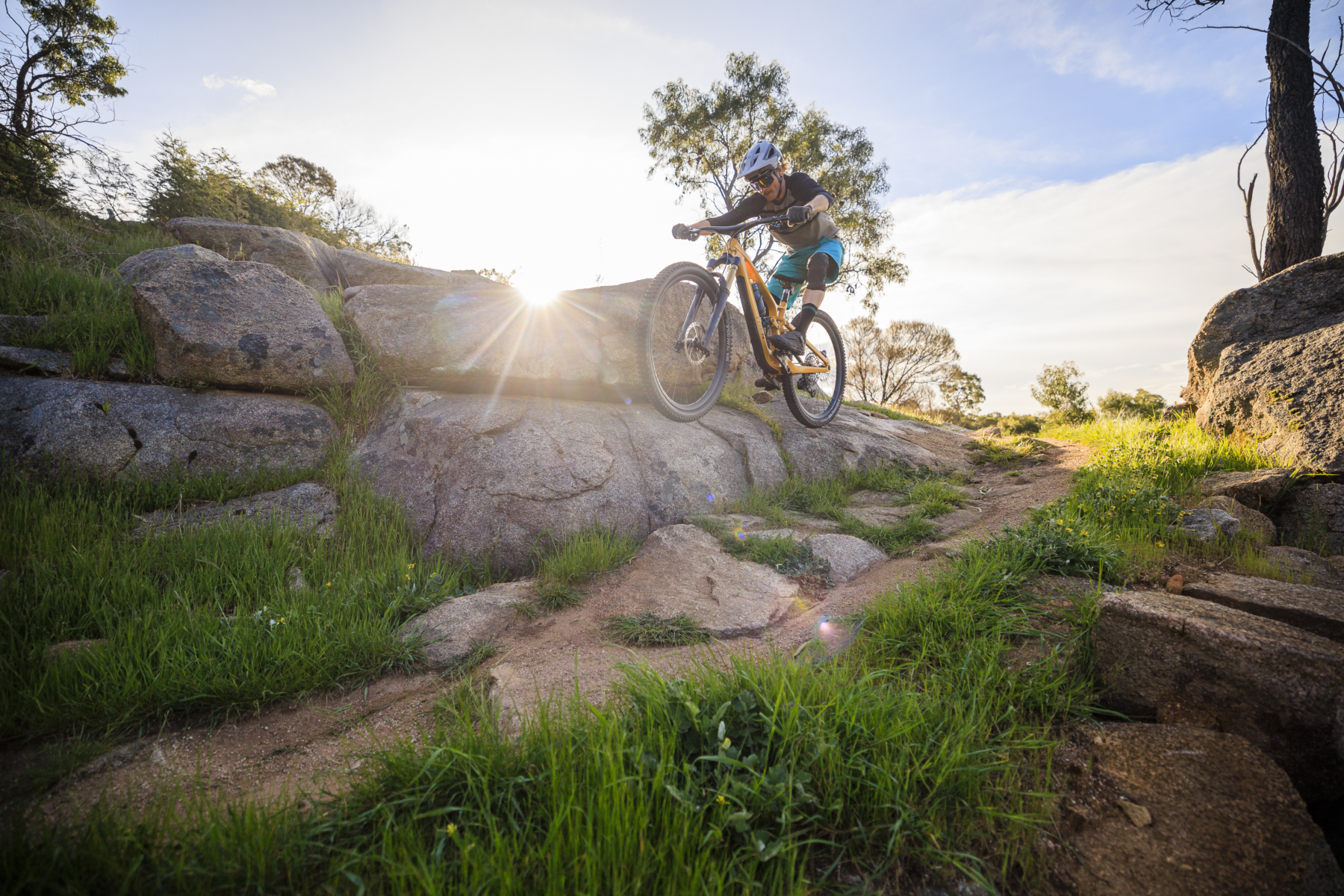
You’ll still want to look towards the Slash if you’re serious about racing, but outside of the tape the Fuel EX will handle just about everything a modern trail centre or bikepark could throw at it.

- Submit for Review
- Terms & Conditions
Enjoy reading this?
Get similar articles delivered directly to your inbox
FIRST RIDE REVIEW
The new trek fuel ex review.
Photos & Words by Dario DiGiulio
As mountain biking has evolved into what it is today, the trails we ride on have slowly but surely raised the bar of what modern bikes have to keep up with. Sure, some tracks have been sanitized over time, but there’s no question that the pointy end of the sport has kept pushing forward. As a result, trail bikes have had to pick up the pace to match the expectations of the average rider, leading to more capable and confident rigs with every new model. Stepping up to the plate, we have the evolved version of the Trek Fuel EX, Trek’s mainstay trail bike. This time it’s really meant to do it all, riding anywhere and doing anything. Being this adaptable can be a tricky task though, so has Trek painted themselves into a corner?
The new Trek Fuel EX breaks just about every mold that the prior generations had fit into, with a full-on redesign for the new model. The name of the game here is adaptability, whether in the geometry, the suspension kinematics, or even what size wheels you’ll run. Thanks to their Mino Link flip chip and two sets of press-in headset cups, you can shift the character of this bike drastically to suit your terrain and preference. As a result, it’s a bit hard to parse out the specific geometry of the bike (however Trek’s site features a geometry tool to let you do so), so I’ll just speak to it in its most neutral form, which is where many will likely settle. There are a whopping 8 size variations to this bike from XS to XXL, so it’s worth digging through the geometry tables to see which might suit you best. They’re all sporting 140mm of rear travel with a 150mm fork, upping the numbers on the prior generation by 10mm.
I’ve been testing the large frame, which puts the reach and stack at around 485mm and 621mm, which are in line with the majority of the industry right now. In keeping with the new Trek Fuel EX’s theme of being adaptable and capable. In its neutral-low setting, the bike comes with a 64.5-degree head tube angle and the effective seat tube angle sits at 77.2-degrees. Chainstays shift with the frame size, and on a large come in at 440mm. Thanks to the Mino Link flip chip, you can adjust bottom bracket height by 8mm up from the slammed 38mm drop in stock configuration, with a 0.6° steeper head tube and seat tube angle. The more significant head tube adjustment comes from the independent press-in headset cups that Trek supplies, which can steepen or slacken things by a full degree, giving a very wide range of handling characteristics. The last frame toggle is the progression flip chip, offering a simple more or less option to tailor the suspension feel and offer uncompromised coil shock compatibility.
As is trend right now, you can set the Fuel Ex up as a mullet, simply by popping a 27.5” wheel in the rear, swapping the Mino Link to high mode, and bumping up fork travel to 160mm. The bike comes stock as a 29er front and rear (or 27.5″ in XS and Small), so you’ll have to make this change on your own accord.
A notable thing lacking from the newest Fuel EX its the Knock Block – you’ll find no such thing on this frame. X-up fans take note, as this is a big move for the engineers in Waterloo, Wisconsin, and was necessary to achieve the headset adjustment range they wanted. Trek has also moved away from the RE:aktiv damper shock, now simply relying on an off-the-shelf model. Still included in the frames are the handy-dandy stash box in the down tube, with what I think might be the best weather sealing of any of the options on the market at this point, and a neat BITS tool roll.
Build kits come in as many flavors as the sizes, and the range of options is quite extensive, beginning at a respectable $3,699. I’ve been on the highest end build, the 9.9 AXS especial, coming in at a healthy $10,749. From Bontrager Line 30 carbon wheels, to the RSL one-piece carbon cockpit, to the XX1 drivetrain, just about everything is as nice as it gets, as you’d hope for this kind of money.
At my height of 6’3”, the geo combination of the Neutral-Low-More flip chip configuration on the large size makes for a really comfortable fit, one that feels stable enough at speed while still remaining lively for your average trail. I started my time testing the bright yellow Trek up in Whistler, riding some gnarly rocky pedal-access trails around the Valley. This was a great context for deciding where I stood on the less or more progression debate, and I settled on the latter end of the spectrum. Increased bottom-out resistance and a more supple top of travel were worth a slightly punchier suspension feel, and I stand by that choice for most of the riding I have around me. On my home trails in Bellingham, the Fuel has been a choice companion for fast and fun rides in our local trail systems, where technical and engaging climbs lead to fast, rooty, and jump-filled descents. My general synopsis is that this is a bike that loves to ride fast, both up and down.
The climbing characteristics are comfortable and neutral, without wallowing too much or lacking grip in trickier terrain. Like many of the take-aways of the bike as it comes stock, things are extra-medium, in the best way. Compared to the new Hightower, the bike has slightly less support, but is significantly better in rough terrain and successive hits. Compared to the Stumpjumper EVO, the Fuel EX is definitely more of a trail bike, less of the all-mountain enduro-lite ride that the Specialized offers. All three bikes serve as a nice gradient from the lighter and sportier end of the trail spectrum to the burlier and more capable side of the category. Sitting pretty right in the middle is the Fuel EX, but I’m sure one could tweak it to either of the other extremes, given how much variability is baked into this frame.
Build kit notes are mostly positive, which you’d hope to see from the highest end build. My main gripe is with the Bontrager SE5 tires, which are some the least confidence-inspiring I’ve ridden in recent memory. The casing and tread pattern are fine, but the compound doesn’t seem to want to hook up anywhere, whether it’s dry loose terrain, rock slabs, and especially wet roots. This would be an immediate swap in my book, and I’d just keep the stock tires to run in the rear when conditions are dry and beat at the peak of summer.
The removable shuttle pad doesn’t seem to want to stay close to the frame, and bows out slightly when attached, giving the downtime a funny bulged look to it. One other frame annoyance has been a recurring suspension knock, despite chasing through every bolt in the linkage with a torque wrench. I still have yet to find the culprit, but luckily it’s not very noticeable when riding.
As a system, I’ve been more than impressed by Trek’s work on the new Fuel EX. Not only does it feel quick and confidant in the stock configuration, it also offers a whole host of layout options to better cater the bike to your preferences.
THE WOLF’S FIRST IMPRESSION
To close out our review of the new Trek Fuel Ex, it’s clear that Trek’s engineers and designers set out to design a bike that caters to that wide center of the market – the trail bike – where most riders spend their time, and where a bike can take many forms. In that goal, they found success. Sure some riders may feel the new Fuel EX has departed from what they were used to and liked about the bike, but many other riders will likely welcome the advancements in capability and confidence on the trail. The Fuel EX is a highly adaptable bike that feels comfortable in a really wide variety of terrain but doesn’t confuse itself for anything more or less. Bike riders, rejoice.
TREK FUEL EX 7
Price: $3,699.99
Frame: Alpha Platinum Aluminum, internal storage | 140mm Fork: RockShox 35 Gold RL | 150mm Shock: Fox Performance Float EVOL
Drivetrain: Shimano SLX/XT Brakes: Shimano MT420 4-piston
Wheelset: Bontrager Line Comp 30, Rapid Drive 108
TREK FUEL EX 8
Price: $4,299
Frame: Alpha Platinum Aluminum, internal storage | 140mm Fork: Fox Rhythm 36 | 150mm Shock: Fox Performance Float X
Drivetrain: Shimano XT M8100 Brakes: Shimano Deore M6120
TREK FUEL EX 9.7
Price: $6,249.99
Frame: OLCV Mountain Carbon, internal storage | 140mm Fork: Fox Rhythm 36 | 150mm Shock: Fox Performance Float X
Drivetrain: Shimano SLX/XT Brakes: Shimano Deore M6120
TREK FUEL EX 9.8
GX AXS Price: $7,699.99 XT Price: $6,749.99
Frame: OLCV Mountain Carbon, internal storage | 140mm Fork: Fox Performance 36 | 150mm Shock: Fox Performance Float X
Wheelset: Bontrager Line Elite 30, OCLV Carbon, Rapid Drive 108
GX AXS BUILD Drivetrain: SRAM GX Eagle AXS Brakes: SRAM CODE R
XT BUILD Drivetrain: Shimano XT M8100 Brakes: Shimano XT M8120
TREK FUEL EX 9.9
XX1 AXS Price: $10,749.99 XTR Price: $9,749.99
Frame: OLCV Mountain Carbon, internal storage | 140mm Fork: Fox Factory 36 | 150mm Shock: Fox Factory Float X
Wheelset: Bontrager Line Pro 30, OCLV Carbon, Rapid Drive 108
XX1 AXS BUILD Drivetrain: SRAM XX1 Eagle AXS Brakes: SRAM CODE RSC
XT BUILD Drivetrain: Shimano XTR M9100 Brakes: Shimano XTR M9120
LEAVE A COMMENT, WIN FREE SWAG!
Want to win some free schwag? Leave a comment and vote up the most thoughtful comments and each month we’ll pick a winner. The person with the smartest and most helpful replies will earn some sweet new gear. Join the Pack and get the latest news and read the latest reviews on the top mountain and electric mountain bikes .
- Pinkbike.com
- Register New User
- First Looks
- Friday Fails
- Community Blogs
- Fantasy League DH
- Places Directory
Review: Trek's All-New 2020 Fuel EX Trail Bike
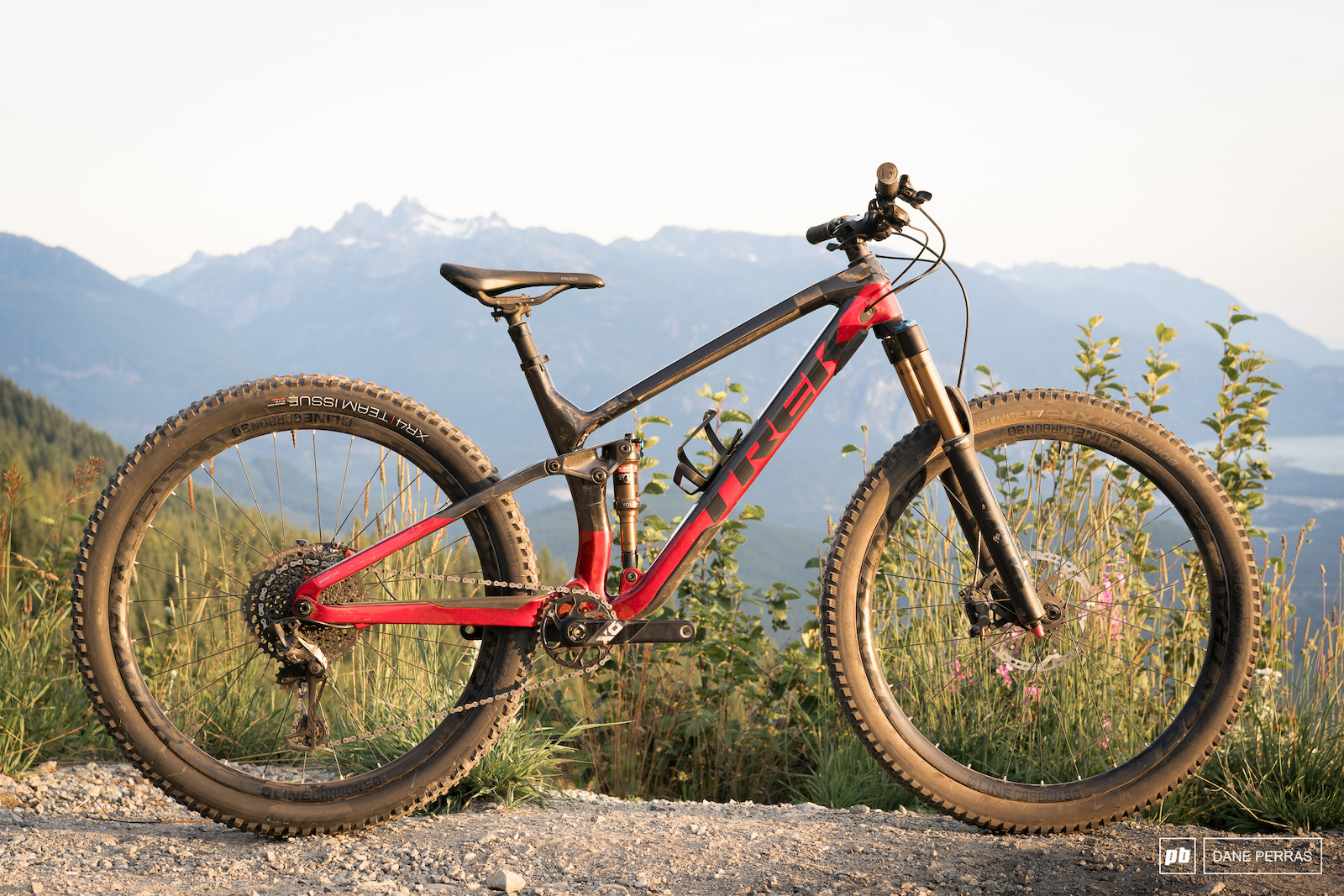
Cool Features

IMAGES
VIDEO
COMMENTS
Trek Fuel EX 9 29er kokemuksia? By pasma in forum Fillarisuositukset Vastaukset: 80 Viimeinen viesti: 23.02.2022, 21.07. Trek Top Fuel. By aland in forum ...
Trek’s most affordable Fuel still lights our trail riding fire
An overview of the Trek Fuel EX 2023. For 2023, the Trek Fuel EX is built around an entirely new frame that’s produced in carbon and alloy variants. Suspension travel has increased by 10mm at both ends, with the new Fuel EX now sporting a 150mm fork and 140mm of rear travel via the ABP four-bar suspension design.
THE NEW TREK FUEL EX REVIEW. As mountain biking has evolved into what it is today, the trails we ride on have slowly but surely raised the bar of what modern bikes have to keep up with. Sure, some tracks have been sanitized over time, but there’s no question that the pointy end of the sport has kept pushing forward.
There are nine 2023 Fuel EX models that start at $2,699.99 USD, but only eight of them are new bikes. That first price is for the EX 5 that's actually a carry-over using last year's aluminum frame ...
The fifty-second generation of the Fuel EX is by far the most radical, most adjustable, and probably the most capable that Trek has ever put together.Support...
Trek makes bikes for the masses, and with the Fuel EX 5 they are offering a quality, versatile trail bike at an accessible price. Of course, $2,100 is still a chunk of change, but in a world where mountain bikes can cost upwards of $10K, we feel this is a great value. This is an excellent entry-level trail bike that would serve a lot of riders ...
Trek Fuel EX. Price: $7,700 (as tested) Buy from Trek Bikes. The Trek Fuel EX has always had a little more EXtra than the Top Fuel, and as the most recent Top Fuel rooted itself even deeper in the 120mm trail/XC department, Trek thickened the borders between the two. The sixth generation of the Trek Fuel EX gained 10mm of travel, with 140mm in ...
There's the obligatory slacker and longer geometry, of course, and Trek even specs the 9.9 and 9.8 models with Fox's stout 36. Fuel EX Details. • Intended use: Trail. • Wheel size: 29 ...
The Fuel EX 8 is an impressively capable, versatile, and well-rounded trail bike that is ready for anything you are. Trek redesigned the Fuel EX models for the 2020 model year, updating the geometry and suspension design. This 29er still falls squarely in the mid-travel category with 130mm of rear suspension and a 140mm fork, but is more ...